#the reference is certainly a Choice. none of the little girl audience is going to get it of course.
Text
When they announced there was going to be a Barbie live action film I honestly had no idea what the hell they were going to make out of the IP
Well I can't seem to fall asleep so I watched the teaser and.... I still have no idea what they're going to do with this film. But the shot for shot reference to 2001: A Space Odyssey sure is a bizarre choice that.... actually makes me think this film COULD be worth watching
#i have never actually seen 2001 btw#but i did see someone put the videos side by side#and yup its basically shot for shot#but when i think of 'barbie film' i would have thought garbage low tier entertainment#bc the entertainment industry looks down on little girls and things they like#and theres a high potential for this film to just be a cheap cash grab?#but actually referencing a film generally considered Extremely Good makes me think...#oh no... this could actually be an extremely clever film?#the reference is certainly a Choice. none of the little girl audience is going to get it of course.#but it kinda.... elevates the film in my eyes??#idk how much sense im making lol
0 notes
Text
Is Anne Boleyn portrayed better than Catherine of Aragon in Tudor dramas or does she just take her clothes off?
Or I've watched almost every Anne Boleyn thing over the past six months and I'm certain at this point you guys are watching different movies than I am
edit: i;m sorry meant to include there is rape mention cw in this
Okay I might get a little mean here, but at this point I'm convinced no one thinks critically about this, like the constant amount of whinging I see about how Catherine is treated just soooo badly in Tudor dramas and always neglected is wild because it is just not true. I would say the only piece of media that treats Anne like a full person is Anne of The Thousand Days, and that's a 50 year old movie. I started thinking about this when I rewatched season 1 of The Tudors back in August because like, it's really abundantly clear who Michael Hirst likes better and it is not Anne. Anne barely feels like a full character in season 1, Henry is madly in love with her,. Her father is scheming to make that worth their while along with George, but where exactly is Anne in all that?
She gets a considerable amount of screentime but very little insight into what she actually feels about all this, is she in love with Henry too? Does she just want to be queen and is manipulating him? We never get an actual moment where it's made clear so you can pretty much apply whatever interpretation you want there, which is bad! Is Anne actually the female lead here, because she doesn't feel like it at all, I feel like this gets forgotten because Natalie adds so much depth to Anne you feel like there's more going on, but there really isn't, Hirst neglects Anne's own feelings about her situation considerably, to a point Natalie has stated she had to push him to give Anne more of a character in season 2. I would say Hirst is just bad at writing women, which like.....he is, but he doesn't have this issue with Catherine, Catherine is a very clear character from the start, which she should be! It's clear what her motives are and what she feels, if I'm honest Catherine in season 1 is probably a little too perfect, like she truly does not have a single negative quality, the worst part is when she calls Anne a whore but I don't think we as the audience is meant to take that as bad on her part which......eh?
The real significance difference is here is how they're portrayed sexually, I do think Catherine and Henry should have had more intimate scenes and Hirst clearly shied away from that because Maria is older, which makes him a coward, but Anne getting treated as a sex object doesn't mean she has better character development, I mean think about that one! I mainly got inspired to write this as I just rewatched The Other Boleyn Girl which I hadn't seen in years and in my memory I thought Catherine hadn't had a good portrayal but like it's fine? She's in most of the movie, she's portrayed as a resilient woman, she gets her Blackfriars speech, is there really a problem here or are you guys actually mad that Natalie Portman is young and beautiful in this and Ana Torrent was in her forties? Because I'll have to draw attention that in this film Catherine again doesn't have a single bad quality while Anne gets raped by Henry before they're even married, so if I was going to get angry about something, I know what it is. It seems to me for years it is been standard to suggest because Anne is portrayed as a young, beautiful women and the utmost sexual desire of Henry's eye that it means she is treated well, but extreme sexulization is actually not interchangeable with respect for Anne as a woman and it is more than obvious than many film makers have absolutely none for her.It is not disrespectful to Catherine to portray her as an older woman, she was 42 when The Great Matter began, there is nothing wrong with being an older woman, the most dramatic parts of Catherine's life took place when she was in her forties, the most dramatic parts of Anne's life took place in her twenties and thirties, that is a simple fact of history.
To open a can of worms that seemed to set a certain part of the internet on fire, let's tackle The Spanish Princess now. Emma Frost and Matthew Graham were quite clear in their veneration for Catherine and their certainty that she has been a maligned figure in history. This seems at odds when you would cross reference most historiography on Catherine, as she seems to be one of the few figures of the Tudor period that has a universally positive reputation .
Through out the two season run both showrunners made their disdain for Anne quite obvious, which was rather odd given they had created a show about Catherine and there wasn't really any need to mention Anne at all. Which makes the choice to include from the start of season 2 particularly bizarre, given historically Anne was in France for the 1510's and would not have been present in the English Court and did not become a Lady in Waiting until in the 1520's. The show does not make it clear who she is and it is only known if you search the role Alice Nokes is playing, which makes her role to be one of heavy handed foreshadowing which simply takes up space to present friendships Catherine had with her actual Ladies of the time. It is not made fully clear who Anne is until the final episode, an episode where Anne is not permitted to speak even though she is in most of the episode and her biggest moment is where she meets Henry late at night in a garden, and removes her clothes to reveal her breasts to him.
Through out the season Anne's male relatives, her father Thomas Boleyn, and her grandfather Thomas Howard are featured prominently. While Anne and her sister Mary are pushed to the side lines and barely given a voice, for a show that claims to present history from the view of women of the era, that seems a choice in poor sport. It could be quite easy to remove Anne entirely from the show, or only make passing mentions of her, instead the choice was to have her exist on the sidelines, mostly voiceless and then to have her be on the forefront as a sexual object to Henry.
In a show that claimed to want to want to give us Catherine's full story, from the time as a 15 year old bride, to a matured, tested Queen, it instead seemed to take a route of focusing on Catherine's less appealing qualities and even gave her faults she never had (as in rejecting her daughter Mary for her gender when it is well known Catherine was an adoring mother). The show seems to think presenting Catherine as a truly unappealing heroine is canceled out by portraying her as a young, beautiful woman, and sexually desired by Henry, that feels extremely insulting to Catherine, who was a tough woman and her best quality certainly wasn't the fact that Henry and Catherine had an active sex life during the first decade of their marriage. You have to see where the decades of presenting Anne as sexually desired by Henry has infected Tudor media in how another Catherine is portrayed here as if a woman should be portrayed positively only through how much their husband desires them. It simply doesn't matter who you prefer over Catherine and Anne, the misogyny of that choice seems quite clear. I simply can't think of a single piece of Tudor media that gives Catherine of Aragon such an offensive role to play.
#anne boleyn#catherine of aragon#the tudors#the other boleyn girl#the spanish princess#rape mention cw
189 notes
·
View notes
Text
planning ≠ coherence
I talk a big game about liking coherence in art, and it’s probably clear that I have an apophenic tendency to enjoy textual interpretation. And this might lead people to think that I have a preference for carefully planned and plotted art, or that I look down on the messy and improvisational. But this is actually almost the opposite of the case. Not because I don’t really like coherence, but because artistic coherence is something more complicated than planning, and isn’t even necessarily possible to achieve with planning.
The thing about improvisation, is that at its best it’s about finding the choice that feels right. I listen to jazz more than any other kind of music, and one of the reasons I like it so much is the exhilaration of someone landing on a musical idea that simultaneously makes a song feel bigger and more complete. A solo isn’t fun if it’s just a bunch of disconnected ideas (similar to how whimsy isn’t fun if it doesn’t also “work”). It’s fun if it picks up on the things that the other players are doing, or ideas that showed up earlier in the song, and then makes them feel like they go together. Even if they “go together” in the sense of being coherently discordant, eg repeating ideas that don’t work multiple times. If beauty is fit, then the joy of improv is finding fit in unexpected places.
This goes for narrative too. In long-running stories like comics, book series, and TV shows, much is often made about whether certain choices were planned from the beginning. If things were planned, that’s a reason for praise, and if things weren’t planned, that’s a reason for derision, either towards the showrunners or towards people attempting to interpret the work. Say, “This plot point only happened because an actor wanted to leave the show. Therefore it has no meaning to read into.” But making things up as one goes is not what makes a story lose its plot, so to speak. Making things up is only a problem if the things the artist makes up don’t go with what came before.
In Impro, a very excellent book about the craft of improvisation, Keith Johnstone calls this process of making-things-go-with-what-came-before “re-incorporation”:
The improviser has to be like a man walking backwards. He sees where he has been, but he pays no attention to the future. His story can take him anywhere, but he must still ‘balance’ it, and give it shape, by remembering incidents that have been shelved and reincorporating them.
Johnstone is big on the idea that satisfying narrative depends on a sense of structure, and that reincorporation is one of the most important tactics for creating structure. To paraphrase him, a story where a character runs away from a bear, swims across lake, and finds a woman in a cabin on the other side, and “makes passionate love” to her has no structure. It’s just a series of events. Whereas if the bear then knocks the cabin’s door down and the woman cries out that it’s her lover, then suddenly it feels like a story. Because not only has the bear been reincorporated, it has been linked to the woman. From this perspective, if a story has no sense of reincorporation, or new developments don’t make sense with what came before, then it will feel incoherent, no matter how planned out it was.
I also keep thinking about Paul Bouissac’s discussion of gags and narrative in The Semiotics of Clowns and Clowning. He explains that what makes a scene funny is not whether it strings a bunch of gags together, but how those gags are organized. To use an example from the book, it’s one thing for a clown to pretend to hurt its thumb, and ask for an audience member to kiss it. It’s another thing for it to keep hurting different parts and then finally hurt its groin and act scandalized at the idea that someone might kiss it. Bouissac calls this sort of repetition “anaphor”:
Anaphor is one of the main tools of textual consistency. In linguistics, it designates the use of pronouns or any other indexical units to refer back to another word or phrase in the text. It links together parts of sentences and bridges the grammatical gaps between clauses, which is a consequence of the linearity of language. In rhetoric, anaphors are repetitions of words or structures that build up the cohesion of discourse and create momentum toward a climax. In multimodal communication, words, gestures, objects, or musical tunes can play the same role by reminding the receiver—that is, the spectator in the case of a performance—of signs and events produced earlier in the act.
One of the things that fascinated me about Farscape as a teenager, was that in contrast to other scifi of the time, it made no pretenses of having been planned—unlike say, Babylon 5. Or even shows like The X-Files, Lost, or Battlestar Galactica that gave you the “feeling” of a plan whether or not they had one, or were capable of following through. Farscape felt incredibly coherent, both in terms of theme and plot, but this coherence came about purely on the strength of the writing’s ability to ideate and then reincorporate. It would take someone’s weird costume idea, like the villain having glowing rods that screw inside his head, and snowball that into a whole storyline where the villain is a half breed of one hot-blooded race and one cold-blooded race, and can only stay alive by thermo-regulating the inside of his brain. And then decide that his vendetta against the hot-blooded race has motivated his obsession with the protagonist since the first season. Yet these twists never feel like “ret-conning” in a pejorative sense, because it all feels narratively and thematically sensible. (Unsurprisingly, making the show was described as “more like improv jazz than plotting out a symphony”).
None of which is to say that I dislike planning or polish, either. Stephen King, as a so-called “discovery” writer, famously writes off the cuff, without outlines. As he puts it in On Writing:
You may wonder where plot is in all this. The answer—my answer, anyway—is nowhere. I won’t try to convince you that I’ve never plotted any more than I’d try to convince you that I’ve never told a lie, but I do both as infrequently as possible. I distrust plot for two reasons: first, because our lives are largely plotless, even when you add in all our reasonable precautions and careful planning; and second, because I believe plotting and the spontaneity of real creation aren’t compatible. It’s best that I be as clear about this as I can—I want you to understand that my basic belief about the making of stories is that they pretty much make themselves. The job of the writer is to give them a place to grow (and to transcribe them, of course).
But his best stories feel like whatever bloat might have been generated from this narrative improvisation has then been pared down to what that improvisation was really getting at. And I can’t lie, I get a particular joy from reading or watching something and feeling without a doubt that the artist is in complete control of my experience. It was one of the most gratifying aspects of rewatching The Wire recently: the feeling that the little meanings and foreshadowings I was seeing in each choice were almost certainly intended. Nothing is more satisfying to an apopheniac than feeling like the patterns you see are actually real. And nothing is more annoying than a story that tries to pull some sort of reveal on you (“Dan is gossip girl!” “Angel is Twilight!” “Rey is a Palpatine!”) that doesn’t make any sense because it wasn’t intended from the beginning. Just because those characters existed in the story before, doesn’t make it good reincorporation. So if a story is a story because of structure, then if the choice is between a planned structure and no structure, the former is almost certainly going to be better.
Point is, it’s not really the process that matters. All creativity is improvisational in a sense, because all creativity involves making things up. What matters is how dedicated an artist is to the integrity of their work. If a writer has carefully planned their whole story out, with every twist and every theme clearly in mind, but can’t adapt if they start writing and find out that something they planned doesn’t actually work, that’s one kind of failure mode. The narrative equivalent of designing a perfect castle and then building it on a swamp. On the other hand, if a writer tries to go with the flow, but can’t reincorporate that flow, then that will be another failure mode. To the extent that I respond to improvisational art, it’s because improvisational art is often more attuned to these questions of whether something is moment-to-moment right. But what matters, above all, is the rightness. That’s what defines coherence. Whether there is a sense in the work that it is oriented around something, and whether the choices contribute to that something.
#posts: art#i could've also connected a pattern language to this#and the post about how it's the solution to high modernism#but hopefully the castle-on-a-swamp analogy will encompass that#the philosophy of 'here are things that generally work but also any solutions must be adapted their environment'
414 notes
·
View notes
Text
Put On Your Raincoats #21 | Double Chinn Double (Double) Feature (with Hyapatia Lee)

By the time the '80s rolled around, Bob Chinn, best known for his collaborations with John Holmes (the inspiration for Boogie Nights), had been directing movies for over a decade. For much of that time, he'd been making them for peanuts (in an interview with the Rialto Report, he recounts being once asked to make a movie for five thousand dollars, which was handed to him in fifties on the spot), but in the early '80s, he was directing for Harry Mohney's Caribbean Films, working with respectable budgets (by porn standards). Some of these films starred Hyapatia Lee, one of the most popular porn stars of the era and one of the first contract girls. Now, I suspect these aren't necessarily the defining works of Chinn's career, and I do intend to get to some of his movies with Holmes. But Vinegar Syndrome had a sale and there were two double features of their collaborations going for dirt cheap, and because I am weak and foolish with money, they ended up in my cart and a few weeks later in my grubby little paws. How did this happen? Through the magic of Canada Post, of course! Anyway, what I found was that these didn't represents any extremes of artistic ambition. They were neither seeking to elevate the genre, nor were they hackwork. Rather, they represent a happy medium, movies that seek to deliver the genre's goods in a polished, diverting package. Slick cinematography, courtesy of Jack Remy. Catchy theme songs that wouldn't sound out of place if you caught them on the radio. Flashy titles. Lee recounted the atmosphere on set as one of professionalism and engagement, where everyone present wanted to do as good a job as possible. Chinn claims to have been losing interest in his work at this point, but the results onscreen are the result of confident execution by somebody who had been doing this kind of thing for years and knew how to put the production's resources to good use.
The first one I watched was The Young Like it Hot, where the operators at a phone company worry about being replaced by computers. To keep their jobs, they scheme to go the extra mile in helping their callers. As this is a porno, most of this help is sexual in nature, as when Rosa Lee Kimball stays on the line while an obscene phone caller played by Bill Margold finishes. (In an interview on the DVD, Margold says after shooting his scene, he was invited to record additional dialogue. Being the method actor that he was, he insisted on whipping it out during the recording session despite the lack of cameras.) Sometimes they are informative, as when Bud Lee (real life husband of Hyapatia at the time) explains why the perineum is referred to as taint ("cuz it taint cunt and it taint ass"). But the highlight of their efforts are Shauna Grant's increasingly life threatening home improvement advice to one poor sap played by Joey Silvera. Hyapatia Lee is ostensibly the star, and has a certain charisma, playing the supervisor, but this is really an ensemble piece, and she's joined by more experienced actors like Kay Parker and Eric Edwards. The latter I've occasionally found bland elsewhere, but he has a nice obnoxious quality that serves him well as the villainous manager whose idea it is the automate the operators' jobs. The movie reflects a very real concern (that's very much still an issue in the modern workplace), but overall this is a breezy, affable comedy.
A bit more serious in tone is Sweet Young Foxes, a coming of age story whose dramatic parts are more sensitively realized than I expected. The screenplay was written by Deborah Sullivan, Bob Chinn's wife at the time, and this is a case where a movie definitely benefited from having been written by a woman, and it seems like an earnest effort to capture the anxieties and yearnings of its young women protagonists. Lee moves closer to a real starring role, and is joined by Cara Lott and Cindy Carver as her friends, who aren't quite as strong actors as her but do have decent chemistry. I can believe they're friends even if their line delivery can be stilted. (That the movie has a good ear for genuine sounding dialogue also helps.) Kay Parker is especially good as Lee's mother, hitting some of the same notes as Taboo, and has a credibly emotional masturbation scene in front of a mirror that did not leave me unmoved. (In what way? That's none of your damn business.) This was shot by Jack Remy, the same cinematographer who worked on The Young Like it Hot. That movie looked nice and slick, but this one is a little more stylish, with the solo sex scenes in particular resembling magazine centerfolds. There's also some nice new-wave-ish music that shows up on the soundtrack, which I certainly didn't mind. I do wish some of the sex scenes didn't run quite as long (the previous movie kept them refreshingly concise) as I'd prefer more of the runtime was dedicated to the dramatic elements, but what's there is still good.
Body Girls goes back firmly to comedy territory, where Hyapatia Lee and the members of her gym are trying to win a bodybuilding contest despite a rival gym's attempts to undermine them. This comes in the form of a pair of schlubs in yellow tank tops who break into the gym after hours to sabotage their equipment, only to be foiled by Hyapatia and her girls who just happened to be having sex in the locker room as people do. Of course, despite Lee's attempts to teach them a lesson (which depending on your proclivities, may have the opposite effect), they don't give up, and during the contest threaten the judge at gunpoint. Not one to take things lying down (okay, poor choice of words here), Lee finds a way to influence the judge back in her favour. (The judge is played by Francois Papillon, bringing a dopey charm to the character as he fumbles through his lines in his French accent.) Her method is pretty ridiculous and certainly in service of genre requirements, but I did laugh.
Now, there's probably a dilemma in audience sympathy here as both Lee and her rivals are cheating, but Lee's methods are more agreeable and directed at the judge instead of her rivals so I guess we ought to root for her. She's also buoyant, charismatic and has a real star quality, and is joined by such fan favourites as Shanna McCullough and Erica Boyer, all of whom sport wildly different hairstyles. As can be expected given the exercise theme, most of the ladies have toned, athletic bodies (and given the decade, voluminous coiffures), with the exception of Tigr, who brings a wiry punkish energy that stood out to me despite her limited screentime, and she also performs the miraculous feat of making a mullet look cute. (I'd previously been moved by her work in Kamikaze Hearts, the great mockumentary about a porn production and her relationship with Sharon Mitchell. She didn't stay in the industry for too long, but I'd be interested in seeing more of her work.) The screenplay was written by Lee with her husband Bud (who plays the judge's assistant with an agreeable presence that's neither too alpha nor too schlubby) and is full of exercise-related dialogue. Most of this is pretty clunky and calling it wordplay might be a bit generous ("sexercise" features at one point), but I did appreciate the effort. Also as is requisite for the premise, the longest set piece in the movie is an orgy in Lee's gym with the various participants snaked around different pieces of equipment. I must note that one of the male actors resembles Barry Gibb and that Francois Papillon is shown to wear a tiger-striped speedo. Did I enjoy the movie? Yes, but not for reasons cited in that sentence.
At the end of Body Girls, Bud Lee suggests to Hyapatia, "Let's get physical", which is the title of the next movie. (Body Girls also features a character looking at dirty magazine with stills from Sweet Young Foxes and ends with a plug for some of these other movies, anticipating the MCU's narrative and marketing strategies by a few decades.) Now, all of these movies have had decent theme songs, but the one in Let's Get Physical has lyrics that are plagiaristically close to those of Olivia Newton-John's 1983 hit. (The delivery however is more shrill but not unpleasing.) This movie is a drama where Lee plays a dance instructor trying to put together a ballet performance despite her strained relationship with her impotent husband played by Paul Thomas. (In the interview I listened to, Lee speaks well of almost everyone she worked with on these films, with the pointed exception of Paul Thomas. If there was bitterness behind the scenes, it arguably helps their performances.)
Lee wrote the screenplay for this one, and unlike Body Girls with its surface level references to bodybuilding and exercise, the dialogue here feels packed with knowledge of the real thing, which is understandable given Lee's real life interest in dance going back to her childhood. (I looked up "Luigi jazz dancing" after finishing the movie and was pleasantly surprised to learn it was a real thing.) This movie goes all in on her star power, and features a number of dance numbers that seem genuinely interested in the form rather than just leering at the performers. (There is one scene where the song Lee dances to sounds suspiciously like "Beat It".) I did appreciate that the sex scenes were kept relatively concise and tied into the dramatic aspects, although in some cases, the choices made could be goofy, like the scene where Lee makes love to her student Shanna McCullough while Thomas, in a dramatically justified but still awkward gesture, watches from another room and jacks off. (I assume he's playing the audience in this scene. Also, McCullough's character remarks "I've never done this before" when going down on Lee, and yeah, okay Shanna.) Other highlights include a car stunt that may or may not have been lifted from elsewhere but still looks decently executed, as well as a dream sequence where Thomas (or his character at least) plays the piano and sings a song. This is held back a bit by the genre's demands, like when it places a completely superfluous sex scene at the end after Lee's reconciliation with Thomas, but on the whole this is probably the best one of the lot.
#film#put on your raincoats#movie review#the young like it hot#sweet young foxes#body girls#let's get physical#bob chinn#hyapatia lee
28 notes
·
View notes
Text
RWBY Recaps: Volume 8 “Dark”
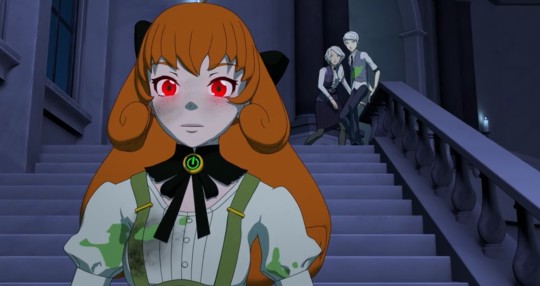
Welcome back, everyone! Can you believe it's been six weeks already? I can't. Something something the uncomfortable passage of time during a pandemic as emphasized by a web-series.
But we're here to talk about RWBY the fictional story, not RWBY the cultural icon. At least, we will in a moment. First, I'd like to acknowledge that shaky line between the two, growing blurrier with every volume. A sort of good news, bad news situation.
The bad news — to get that out of the way — is that we cannot easily separate RWBY from its authors and those authors have, sadly, been drawing a lot of negative attention as of late. This isn't anything new, not at all, but I think the unexpectedly long hiatus gave a lot of fans (myself included) the chance to think about Rooster Teeth's failings without getting distracted by their biggest and brightest production. There's a laundry list of problems here — everything from the behavior of voice actors to the quality of their merch — but as a sort of summary issue, I'd like to highlight the reviews that continue to pop up on websites like Glassdoor, detailing the toxic, sexist, crunch-obsessed environment that RT employees are forced to work in. A lot of these websites requires a login to read more than a page of reviews, but you can check out a Twitter thread about it here.
Now, I want to be clear: I'm not bringing this up as a way to shame anyone enjoying RWBY. This isn't a simplistic claim of, "The authors are Problematic™ and therefore you can't like the stuff they produce." Nor is this meant to be a catch-all excuse for RWBY's problems. If it were, I'd have dropped these recaps years ago. I'm of the belief that audiences maintain the right to both praise and criticize the work they're given, regardless of the context in which that work was produced. At the end of the day, RT has presented RWBY as a finished product and, more than that, presents it as an excellent product, one worth both our emotional investment and our money (whether in the form of paying for a First account, or encouraging us to buy merch, attend cons, etc.) I'll continue to critique RWBY as needed, but I a) wanted fans to be at least peripherally aware of these issues and b) clarify that my use of "RT" in statements like, "I can't believe RT is screwing up this badly" is meant to be a broad, nebulas acknowledgement that someone in the company is screwing up, either creatively (doesn't have the skill to write a good scene) or morally (hasn't created an environment in which other creators are capable of crafting a good scene). The real, inner workings of such companies are mostly a secret to their audiences and thus it's near impossible for someone like me — random fan writing these for fun as a casual side hobby — to accurately point fingers. Hence, broad "RT." I just wanted to clarify that when I use this it's as a necessary placeholder for whoever is actually responsible, not a damnation of the overworked animator breaking down in a bathroom. Heavy stuff, but I thought it was necessary (or at least worthwhile) to acknowledge this issue as we head into the second half of the volume.
Now for the good news: RWBY has reached 100 episodes! For any who may not know, 100 is a pretty significant number in the TV world because, when talking about prime time programming, it guarantees syndicated reruns. Basically, networks don't want audiences to get burned out with a show — changing the channel when it comes on because ugh, I've seen this already, recently too — and 100 episodes allows for a roughly five month run without any repeats, making it very profitable. RWBY is obviously not a television show and doesn't benefit from any of this (hell, modern television doesn't benefit from this as much as it used to, not in the age of streaming), but the 100 episode threshold is still ingrained in American culture. Beyond just being a nice, rounded number, it is historically a measure of huge success and I can't imagine that RT isn't aware of that. Regardless of what we think of RWBY's current quality, this is one hell of a milestone and should be applauded.
All that being said... RWBY's quality is definitely still lacking lol.
Our 100th episode is titled "Dark" — keeping with the one word titles, then — and I'd like to emphasize that, as a 100th episode, it definitely delivers in terms of plot. There's plenty of action, important character beats, and at least one major reveal, everything we'd expect from a milestone and a Part II premiere. The animation also continues to be noteworthy for its beauty, as I found myself admiring many of the screenshots I took for this recap. There are certainly things to praise. The only problem (one we're all familiar with by now) is that these small successes are situated within a narrative that's otherwise falling apart. It's all good stuff... provided you ignore literally everything else surrounding it.
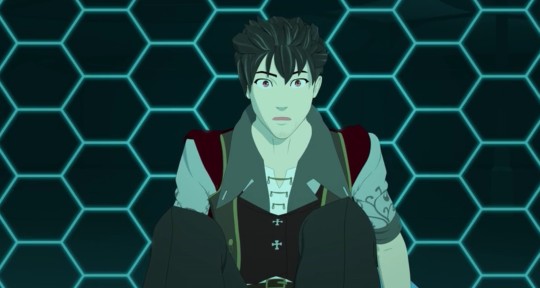
But let's dive into some examples. We open on Qrow starting, awoken by the thunder outside. Robyn has been watching him and makes a peppy comment about how none of them will be sleeping tonight, followed by a more serious, "Sounds bad out there." Yeah, it does sound bad, especially when they all know — thanks to Ruby's message back in Volume 7 — that this is due to Salem's arrival. I think a lot of the fandom has forgotten that little detail because people often discuss Qrow as if he is entirely ignorant of what is going on outside his cell. Even if we were to assume that he's forgotten all about the pesky Salem issue (the horror of Clover's death overriding everything else, perhaps) he still knows that Tyrian is running loose in a heat-less city with a creepy storm going on and, from his perspective, the Very Evil Ironwood is still running the show. So it's bad, which begs the question of why Qrow (and Robyn, for that matter) hasn't displayed an ounce of legitimate worry for everyone he knows out there. Thus far, their interactions have centered entirely around Qrow's misplaced blame and Robyn's terrible attempts to lighten the mood, despite the fact that a war is raging right beyond that wall. It's another example of RWBY's inability to manage tone properly, to say nothing of balancing the multiple concerns any one character should be trying to juggle. Just as it rankles that Ruby and Yang don't seem to care about what has happened to their uncle, Qrow likewise doesn't seem to care about what might be happening to his nieces. When did we reach a point where these relationships are so broken that someone can be arrested/chucked into a deadly battle and the others just... ignore that?
So Robyn's otherwise innocuous comment immediately reminds me of how badly the narrative has treated these conflicts and, sadly, things don't improve much from here. We are thankfully spared more of Robyn's jokes when Qrow realizes that what he's hearing can't be thunder. A second later, Cinder blasts through the wall — called it! — and Qrow instinctively transforms.

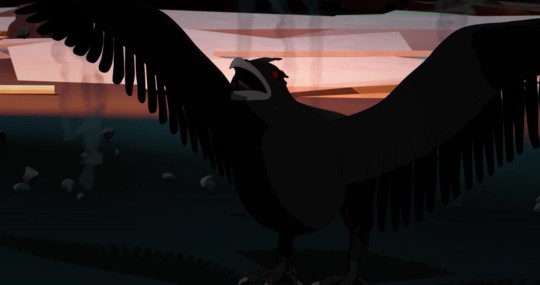
The only downside to this moment is that the whole ceiling falls down on Qrow and the others because APPARENTLY these cells don't have tops on them. Seriously. As far as I can recall we don't see the stone breaking through the forcefield somehow and this looks pretty open to me.

If it is... you're telling me these crazy powerful fighters who practice landing strategies and leap tall buildings in a single bound —
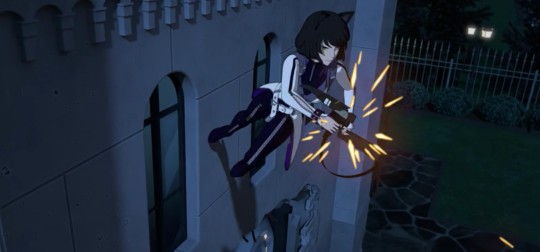
— can't just hop over this mildly high electric fence to get out? Qrow can't just fly away?
We're, like, two minutes in, folks.
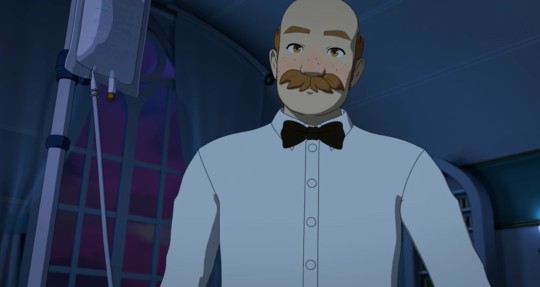
We transfer to Nora's perspective as she wakes up, seeing Klein giving her the IV. He tells her not to worry, that "you and your friend are going to be just fine." What friend? Penny? Klein went upstairs prior to Weiss hugging Whitley or Penny crash landing outside. I had thought them bursting through the door with another unconscious friend was the first time he learned what the big bang outside was, but apparently not.
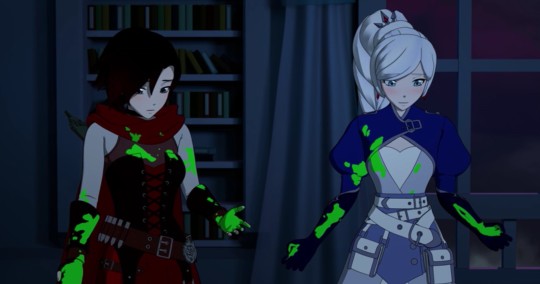
Penny is, obviously, a mess. While I now understand the choice to make her blood such an eye-catching color when that's crucial to the Hound's hunt, I still think it looks strange visually. Like someone has taken a copy of RWBY and painted over it. It doesn't look like it fits the art style. More than that, it implies some rather complicated things about Penny's humanity, especially in a volume focused around her being a "real girl." Real enough for Maiden powers, but with obviously inhuman blood that isn't even referred to as "bleeding." Penny "leaks" instead.
Toss in the fact that she's literally an android who is made up of tech — recall the running gags about her being heavy, or it hurts to fist-bump her, to say nothing of keeping things like multiple blades inside her body — yet Klein says that her "basic anatomy" is the same and he can "stitch up that wound."
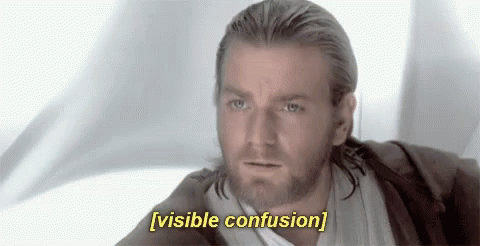
I'm sorry, what? Whatever Penny looks like on the inside, it's not going to resemble a human woman's anatomy, and Klein might be able to stitch the outer layer of skin she's got, but that won't do anything to fix whatever metal bits have been broken underneath. Penny isn't a human-robot hybrid, she's a robot with an aura. Penny has knives in her back, rockets in her feet, and a super computer behind her eyes. When our clip introduced that Klein would be the one to help Penny, my initial reaction was, "Seriously? He's a butler and a doctor and an engineer?" But RWBY didn't even try to get away with a Super Klein explanation, they just waved away Penny's very obvious, inhuman anatomy. Yeah, I'm sure "stitching up" an android wound is just like giving Nora her IV. I hope the surgical sutures he used are extra strong!
In an effort to not entirely drag this episode, I do appreciate that Whitley is allowed an "ugh" moment about the non-blood covering his shirt without anyone calling him out on it. That felt like the sort of thing the show would usually try to make a character feel guilty about and I'm glad that, for once, he was just allowed to be frustrated without comment.
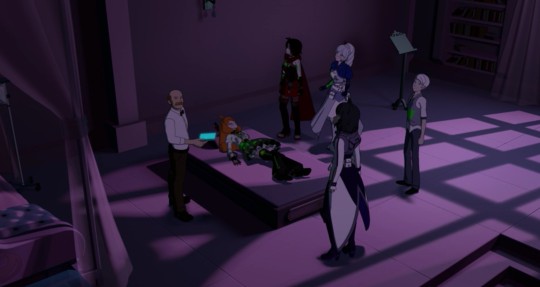
Then the power goes out and May calls, which raises questions about what state the CCTS is in and when scrolls are available to our protagonists vs. when they're not. But whatever. She's checking in because she just "saw another bombing run light up the Kingdom" and —
Wait. Bombing? Salem is bombing the city? I know we've seen explosions in the sky, but I'd always just attributed that to evil aesthetic. Why does this dialogue sound like it's from a World War II film and not a fantasy sci-fi show about literal monsters launching a ground attack?
May looks pretty against the sky though. I like her hair color against that purple.

I'm admittedly grasping at positives here because we finally return to her "You have to choose" ultimatum and — surprise! — May has pulled back completely. Ruby says that once they've helped Penny, "We'll...we'll do something!" which is once again her avoiding making a decision. Ruby still refuses to choose, instead falling back on generic, optimistic pep talks. They'll figure out how to stop Salem later. They'll think about the impact of telling the world later. They'll choose who to help later. Ruby keeps pushing these problems into the future where, she hopes, a perfect, magical solution will have appeared for her to latch onto. When that continues to not happen, others pressuring her to actually do something and stop waiting for perfection — Ironwood, Yang, May — she panics and continues stalling for time. Wait an episode and the narrative supports her in this.
Because initially May was forcing Ruby to decide. Now, May enables her desire to keep putting things off. "Don't beat yourself up, kid. At this point, I don't know how much is left to be done." That's the exact opposite of what May believed last episode, that there was still so much work and good to do for the people of Mantle. This is precisely what the show did with Yang and Ren's scenes too, having people call Ruby out... but then return to a message of, 'Don't worry, you're actually doing just fine' before Ruby is forced to actually change.
None of which even touches on May calling her "kid" in this moment. That continues to be a convenient way of absolving Ruby of any responsibility. When she wants to steal airships or Amity Tower, she's an adult everyone should listen to, the leader of this war. When the story wants to absolve her of previously mentioned flaws, she becomes a kid who shouldn't "beat herself up." I said years ago that RWBY couldn't continue to let the group be both children and adults simultaneously, yet here we are.
So that was a thoroughly disappointing scene. Ruby gets her moment to look sad and defeated, listing "the grimm, the crater, Nora, Penny" as problems she doesn't know how to solve. Note that 'Immortal witch attacking the city I've helped trap here' isn't included in that list. Ruby is still ignoring Salem herself and no one in the group is picking up where May left off, challenging her to do more than wring her hands over things others are already trying to take care of: Ironwood is fighting the grimm, May has gone off to help the crater, Klein is patching up Nora and Penny. Ruby, as one flawed individual, should not be expected to come up with a solution to everything, but she does need to stop acting like she can come up with a solution to everything when it matters most (office scene) and rejecting others' solutions when they ask for her help (Ironwood, May).
If it feels like I'm dragging the flawed, traumatized teenager too much, it's not in an effort to ignore those aspects of her identity. Rather, it's because she's also the licensed huntress who wrested control from a world leader and violently demanded she be put in charge of this battle. Ruby, by her own actions, is now responsible for dealing with these problems, or admitting she was wrong and letting others take the lead, without purposefully derailing their plans. She doesn't get to suddenly go, "I don't know," cry a little, and get sympathetic pats.
But of course that's precisely what happens, courtesy of Weiss.
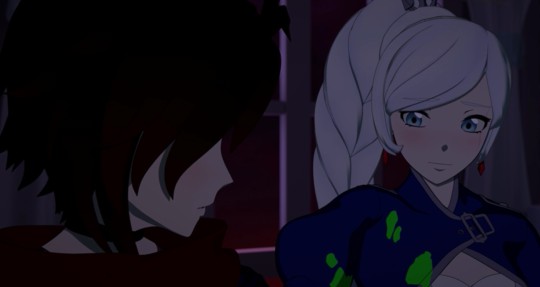
During this whole scene I kept wondering why no one was celebrating Nora waking up, especially when Ruby outright mentions her. Have they just not noticed given all the Penny drama? Because Nora absolutely woke up.

Aaaand went back to sleep, I guess. What was the point of that POV shot? No worries though, she'll wake up again in a minute.

Willow arrives and announces that they can fix the power (and Penny) using the generator at the edge of the property. I'm convinced RT doesn't actually know what a generator is because the characters are acting like it's some super special device that only richy-rich could possibly have. Whitley says that it's the SDC executives who have their "own power supply" and that it's "extremely unfair." Now, don't get me wrong, a good generator powering large portions of your house can run you 30k+, but you can also get one that plugs into your extension cord and powers your fridge for a couple hundred. There's absolutely a class issue here, just not the one Whitley and Weiss seem to be commenting on. They make a generator sound like the sort of device that only a politician-CEO could possible have and it's weird.
Likely, it sounds weird because it's a choppy way of getting Whitley to bring up the wealth disparity so he can then go, 'That's right! We're crazy rich with a company housing tons of ships! We can use those to evacuate Mantle.' Awkwardness aside, I do like that the Schnee wealth is being used for good purposes, but... evacuate where? To the city currently under attack by a giant whale? In a RWBY that wasn't determined to demonize Ironwood, this would have been a great plot point during the office scene instead, with Weiss offering her services to Ironwood, even if the group decides that a continued evacuation still isn't possible.
Instead, we get it here from Whitley. Do I need to point out the obvious? That Whitley is the MVP of this episode? He's done more good in an HOUR than the group has managed in a year. Give this kid some training and make him a huntsmen instead.

We're given a (very pretty!) shot of the shattered moon because it wouldn't be RWBY if we weren't continually reminded that gods once wiped out humanity before destroying part of a celestial body... and absolutely no one talks about that lol.
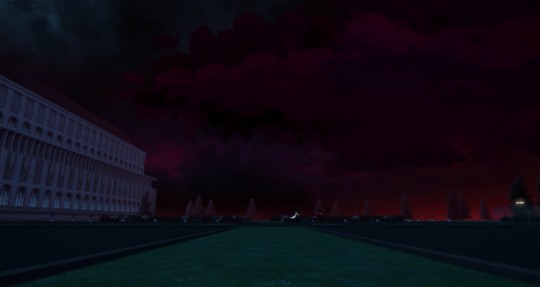
Blake's coat might not make any sense for her color scheme, but it does make her easy to spot as she and Ruby run across the grounds. Oh my god, they're actually doing something together! It only took eight years. They even get a lovely talk where Blake admits how much she looks up to Ruby, despite her being younger, and once again I'm struck at how much more I would have loved this scene if it had appeared elsewhere in the series. It is, indeed, as sweet and emotional as all the RWBY GIF-ers are claiming... provided you overlook that this is the exact opposite of what Ruby needs to hear right now. She doesn't need to hear that she's more mature and reliable than her elders when she's functioning under a "We don't need adults" mentality. She doesn't need to hear that not knowing what to do is totally fine, not when that led to her turning on Ironwood, despite not knowing how to stop Salem. She doesn't need to hear that "doing something" — doing anything — is a strength, because Ruby keeps avoiding the big problems for smaller ones she's comfortable with, like standing by Penny's bedside instead of deciding between Mantle and Atlas. Blake's speech is heartfelt, but it's a speech that suits a Beacon days Ruby who is having some doubts about her leadership skills, not the girl whose impulsive — and now lack of — actions is having world-wide repercussions. Everyone is babying Ruby to a staggering degree. It's like if we had a med show where the doctor is standing by the bedside of a coding patient, fretting between two treatments. 'Don't worry,' their colleague says, patting their shoulder. 'I've always looked up to you. You'll do something when you're ready' and then they continue to watch the patient, you know, die.

Also: who does Ruby look up to? Everyone talks about how much they depend on and trust Ruby, but who does Ruby look to for guidance? A number of her problems stem from the fact that she has rejected the advice of everyone who has tried to help her improve: Qrow, Ozpin, Ironwood, even Yang. Ruby is presented as the pinnacle of what to strive for in a leader, rather than a leader who has only been doing this for two years and still has a great deal to learn.
Anyway, they get the generator on and the Hound shows up.
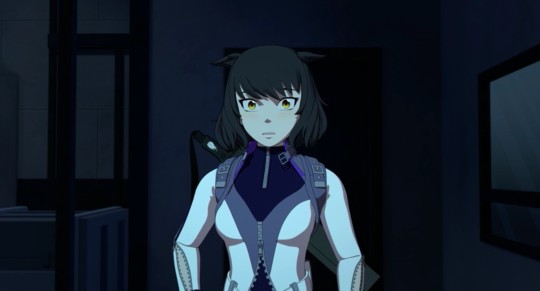
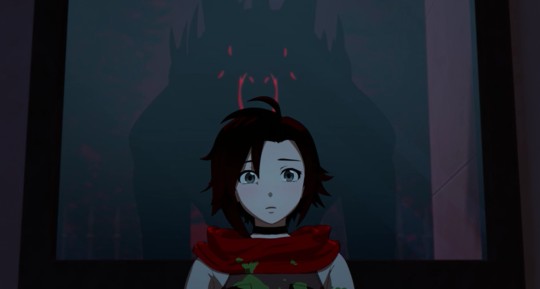
I am begging RT to just make RWBY a horror story. All their best scenes the last three years have been horror I am bEGGING —
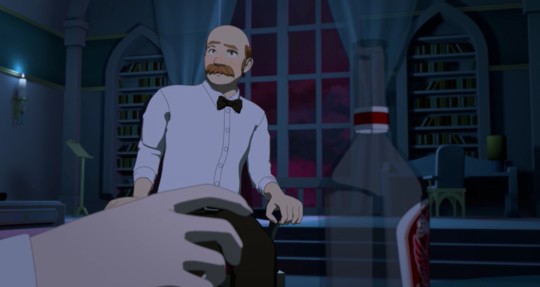
Anyway, while Ruby waits to be eaten we cut to Willow and Klein, the former of which is reaching for her bottle, pulling back, reaching again, all while her hand shakes. This is good. This is what we should have gotten with Qrow. Which isn't to say that their (or anyone's) addiction should be identical, but rather that this is a far more engaging and complex look at addiction than what our birb got. Willow tells us that she doesn't drink in the dark despite bringing the bottle with her; tries to resist drinking when she's scared and ultimately fails. Qrow just decided to stop drinking after decades of addiction, seemingly for no reason, and that was that. Why is a side character we only met this volume written better than one of the main cast?
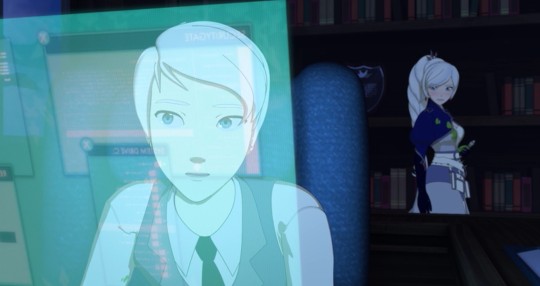
Blake manages to call Weiss about the Hound and she asks if Whitley can handle the airships without her. I mean, I assume so given that Weiss is looking at the bookshelves while Whitley does all the work lol. He makes a teasing comment about how he can if she can handle that grimm and she comments that they still need to work on his "attitude."
No they don't. Weiss stuck a weapon in her kid brother's face. Whitley made a joke. Even if Weiss' comment is likewise meant to be read as teasing, it's clear that we've bypassed any meaningful conversation between them. That hug was supposed to be a Fix Everything moment even though, as I've laid out elsewhere, it didn't even come close.
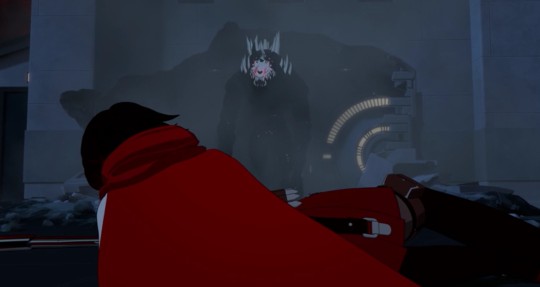
We cut back to Ruby getting thrown through a wall into the backyard and the Hound creepily coming after her. She's freaked out by this clearly abnormal grimm and Blake is weirdly... not? "It's just a grimm. Just focus!" Uh, it's obviously not. Have we reached the traumatized, sleep-deprived point where the group is sinking into full-blown denial? I wouldn't be surprised. They've been awake for like... 40+ hours.
Because the Hound knocks Ruby out with a single hit. Just, bam, she's down. "Focusing" is not the solution here.
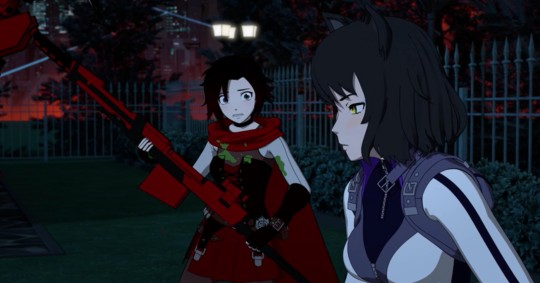

Weiss calls to warn the others about the grimm, telling them to stick together. Willow (understandably) starts freaking out and flees the room (classic horror trope!). Klein is left alone when Penny wakes up with red eyes. Oh no!

Don't worry. You know nothing meaningful happens.
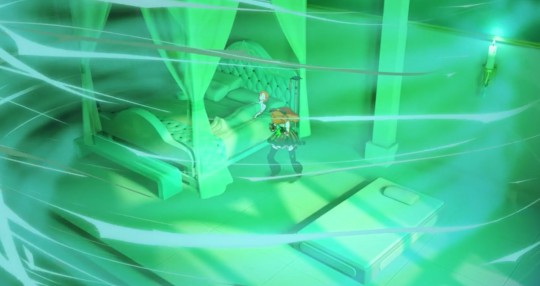
She shoves Klein before (somehow?) resisting the hack, her Maiden powers going wild in the process. Just when it looks as if Penny might cause some serious damage, Nora wakes up, takes her hand, and says, I kid you not:
"Hey... no one is going to make you do anything you don't want to do... It's just a part of you. Don't forget about the rest."
Okay. I want to re-emphasize that I love hopeful, uplifting, victory-won-through-the-power-of-love stories. Istg I'm not dead inside, it's just that RWBY does this so badly. I mean, what is this? It has similarities to the character shouting, 'No! Resist!' to their mind-controlled ally, but this is not presented as a desperate, last-ditch effort by Nora. She just speaks like this is the most obvious truth in the world. If you don't want to have your mind taken over... just don't! It's that simple. The problem definitely isn't that Watts has changed her coding and has implemented a command she can't override, it's that Penny has forgotten about the "rest" of her personhood.
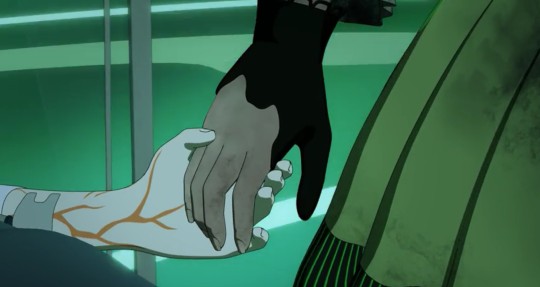
And this works. Granted, not for long, but we leave Nora having successfully calmed Penny down and until her eyes unexpectedly go red again scenes later, we're left assuming that this is a permanent solution. That, imo anyway, is taking the Power of Love too far, overriding the basic reality of Penny being hacked. It’s not a personal failing she must overcome, it’s an external attack. I would have rather had Nora react to the scars she saw on her arm, or have a moment with Klein, or get some love from the group. Not a wakes up, falls asleep, wakes up again to save Penny with a Ruby level 'Just ignore reality' pep-talk, then back to sleep again.
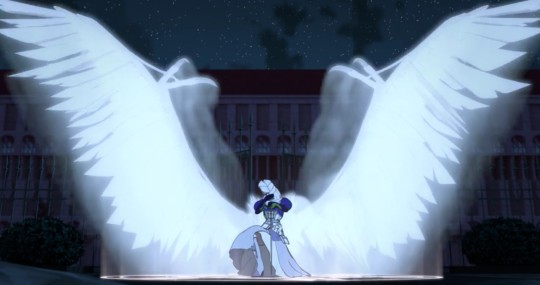
So Penny isn't attacking her allies, or mistakenly hurting her allies with wild Maiden powers. Not that the group doesn't have enough to deal with, but still. Weiss arrives to help with the Hound and attempts a new summon, only to fail when two minor grimm burrow up into her glyphs. I really enjoyed that moment, both for the wing visual and the knowledge that Weiss' glyphs can fail if you break them somehow (which makes sense). Also, I just like that she failed in general? Weiss is, as per usual now, about to demonstrate just how OP she is compared to the rest of the team, so it was nice to see her faltering here.
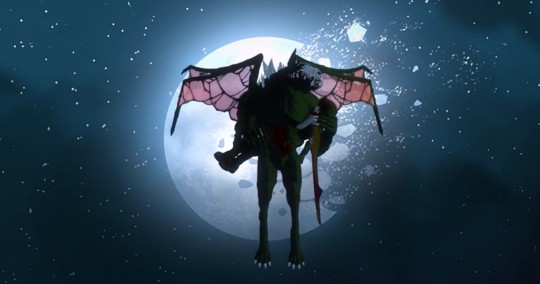
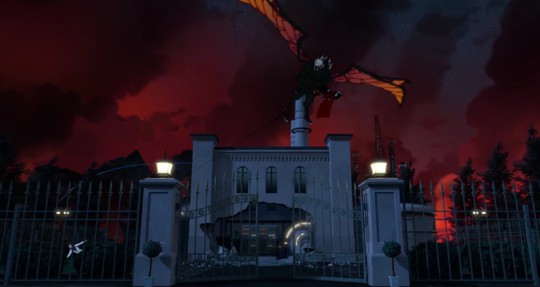
The Hound tries to make off with Ruby and Blake does an excellent job of keeping it tethered. Ruby finally wakes, only to realize that the grimm is actually after Penny since it's staring at her power up through the window, no longer trying to escape. Moments like this remind me that there's someone on RT's writing team that knows what they're doing, at least some of the time. The assumption that the Hound is after Ruby as a SEW, the surprise that it's actually Penny, realizing it holds up because Ruby is covered in Penny's blood and Blake is not... that's all nice, tight plotting. More of that please!

The Hound drops her and Ruby's aura shatters when she hits the ground. I want everyone to remember this moment as an example of how strong the Hound is. The group may be tired, but unlike YJR they've been sitting around in the Schnee manor for a number of hours, regaining strength. We saw the Hound hit Ruby twice — once through the wall and once to knock her out — and then she falls from a not very high distance for a huntress, yet her aura is toast. That's the level of power and skill the Hound possesses. Decimating YJR, knocking Oscar out, same for Ruby, avoiding Blake and Weiss' hits, soon to treat Penny like a ragdoll. Just remember all this for the episode's end.
Blake tells Weiss she'll take care of Ruby, you go help the others. Yay breaking up the duos more! Bad timing though as the new acid-spitting grimm pops out of the ground and Blake is now left alone to face it.
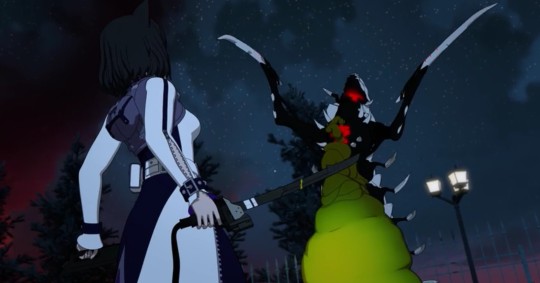
Weiss re-enters the mansion, knowing the Hound is somewhere nearby, but not where. Suddenly, Willow's voice sounds through her scroll with an, "Above you!" which... doesn't keep Weiss from getting hit lol. But it's the thought that counts! Willow has accessed the cameras she's set up throughout the manor, watching the Hound's movements, and I have to say, that is a WAY better use of her separation from Klein than I thought we were getting. I legit thought they'd have Willow run away in a panic, meet the Hound, die, and then Weiss could be sad about losing her mom.
It does say something about RWBY's writing that this was my knee-jerk theory, as well as my surprise when we got something way better.
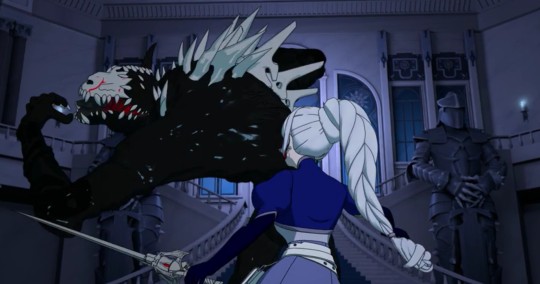
The Hound runs off, uninterested in Weiss, and she asks Willow to keep tabs on it. It heads for Whitley next (also covered in Penny's blood) and very creepily stalks him in the office with a, "I know you're here." Whitley is seconds away from being Hound chow before one of Weiss' boars pin it against the wall. He runs, then runs BACK to finish deploying the airships, before finally escaping assumed death. Goddamn this boy is pulling his weight.

I assume all these ships are automated then? I hope someone takes a moment to call May. Otherwise it's going to be super weird for the Mantle citizens if a fleet of SDC ships just show up and hover there...
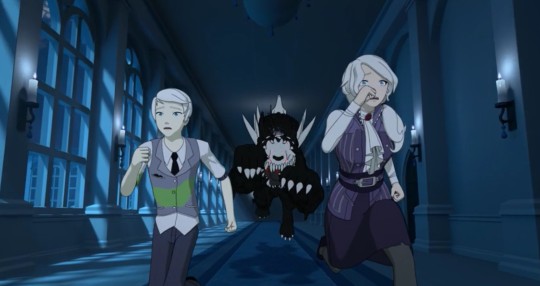
I don't entirely understand how Weiss saved him though. She's nowhere to be seen when Whitley leaves and he runs a fair distance before he and Willow encounter Weiss again. We know her summons don't have to keep right next to her, but are they capable of rudimentary thought, attacking an enemy — and an enemy only — despite Weiss being a couple corridors down and unable to see the current battlefield? I don't know. In another series I'd theorize that this was a deliberate hint, a way to clue us into the fact that Willow, someone who we currently know almost nothing about, had training in the past and summoned the boar herself. Weiss and Winter certainly didn't get that hereditary skill from Jacques. Hell, we might still get that, Weiss reacting with confusion next episode when Whitley thanks her for the boar, but I doubt it. That scene with Ruby and the Hound aside, the show isn't this good at laying groundwork and then following up on it.
Case in point: Weiss says, "I didn't forget you" to Whitley after he gets away from the Hound, the moment trying to harken back to her promise to Willow. Key word is "trying." Because she absolutely forgot him! Weiss threatened and ignored Whitley until he proved his usefulness. I also shouldn't need to point out that, "Don't forget your brother" does not mean, "Don't let your brother die a horrible death by abnormal grimm." Weiss acts like her saving him is a fulfillment of her promise, rather than just the most basic of human decency. And also, you know, her job.
So that part is frustrating. The entire Schnee dynamic is a mess, from Weiss making a joke of her father's arrest, to Willow (presumably) fixing their relationship by putting a hand on her daughter's shoulder. Okay.
Then Weiss cuts off the Hound by summoning a giant wall of ice. My brain, every time this happens:
YOU COULD HAVE FIXED THE HOLE IN MANTLE'S WALL.

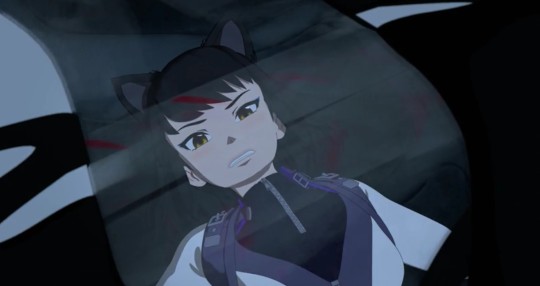
Moving on, Blake's fight against the acid... thing has some great choreography, including Blake using her semblance which we haven't seen in AGES.
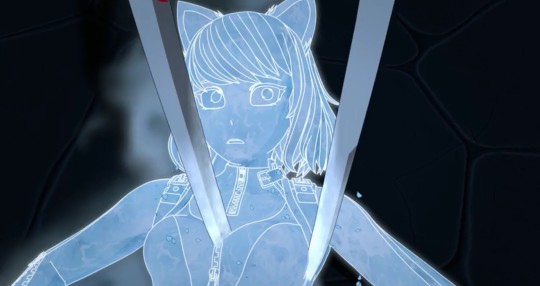
I really like the fight itself, just not what Blake is shouting the whole time. "I need you, Ruby! We all need you!" This has really gotten ridiculous. Ruby is presented as everyone's sole savior despite failing time and time again. It's not that I don't think Blake as a character should have faith in her leader, it's that I don't think the writers should be crafting a story where everyone puts their unshakable hopes in an untrained, disloyal, impulsive 17 year old. I mean, Ruby is currently unconscious, yet Blake is acting like if she doesn't wake up — she, as an individual, if Ruby Rose does not re-join this fight — then all is lost. If Ruby doesn't save them, no one can. Which is, of course, absurd on numerous levels. Blake doesn't need the passed out, aura-less Ruby right now, she needs the still very healthy Weiss pulling out multiple summons and an ice wall! Use your scroll and call for backup again.

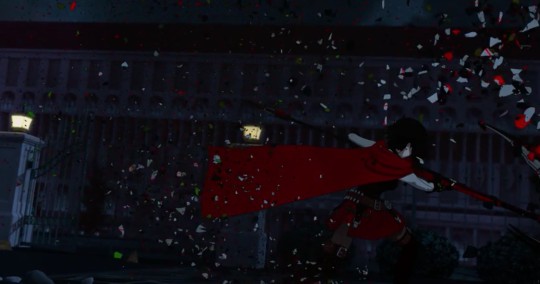
But of course, Ruby wakes up and kills the new, terrifying grimm with a single hit. It's a preview of what's to come with the Hound and it's just as ridiculous here as it will be there.
Speaking of the Hound, am I the only one who thought this was... cute?
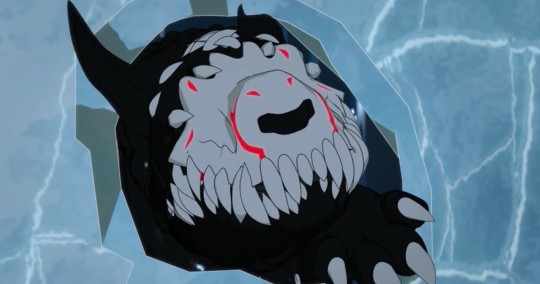
I can't possibly be the only one. That head-tilt is exactly what my dogs do and my brain instinctively went, "Aww, puppy!"
Murderous puppy.
The Hound realizes none of the Schnees are who it's looking for and runs off. Penny, meanwhile, has been fully taken over because, well, that's just what's convenient now. She resists long enough keep Amity up, then succumbs, then resists to apologize to Ruby, then succumbs, then resists because Nora asked her to, then succumbs once it's time to knock her out. If RWBY was willing to commit to consequences, Penny would have been taken over and that was that. The characters would need to deal with whatever outcome happens as a result. Instead, the show very carefully avoids any of those pesky consequences by having Penny successfully resisting at key moments, despite no explanation of how she's managing that.
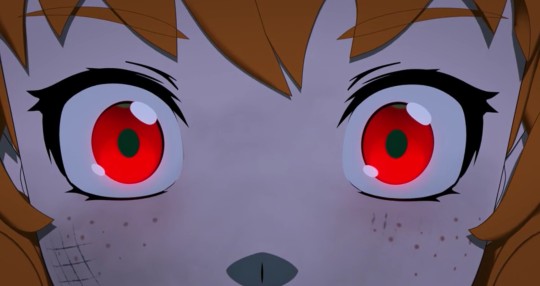
She shoves Klein again (Klein is having a Bad Time) and starts walking down the main steps. When Whitley wants to know where the hell she's going, Penny mechanically responds that she must "Open the vault, then self-destruct." I suppose the change Watts made was the self-destruct order? Ironwood obviously wants the vault open, though not necessarily Penny's death. Think what you will of his moral compass, she's a damn powerful ally — a research project, perhaps — and a Maiden to boot. At the very least, her death may give the powers to someone even worse.
God, please don't let them have brought Penny back and made her a Maiden just to kill her again.
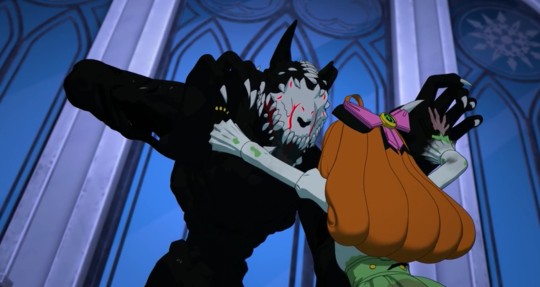
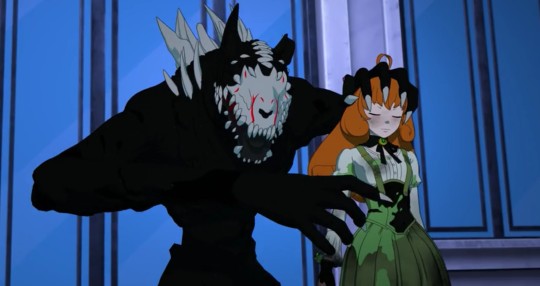
The Hound arrives though and, as said, knocks Penny out. We're back to square one with her, then. Note though that this attack is near instantaneous. She grabs its hands one second, is hanging limply the next. Wow, the Hound sure is a terrifying antagonist!
Not for long.
"That's enough," Ruby says and one-shots it with her eyes.
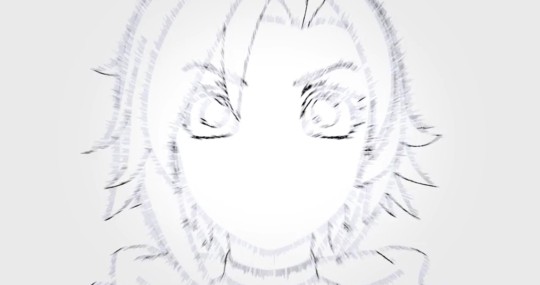
Now, I want to talk for a moment about the implications of that line. "That's enough." Obviously Ruby is #done with this situation and emotionally unwilling to let the Hound kidnap Penny (congratulations, Nuts and Dolts shippers), but there's a meta reading here as well. Not intentional, but glaring to me nonetheless. Basically, the idea that the Hound has, from a plot perspective, done enough. It has served its singular purpose. It kidnapped Oscar and now it dies. Never-mind how insanely powerful we've established the Hound to be, never-mind how Ruby's eyes also work or don't work according to whether anything of actual import is on the line. From a plot perspective "that's enough" and the Hound can be disposed of instantly. It got Oscar and gave us an episode of filler creepiness. Move along now.
The idea behind Ruby's eyes isn't bad, but the execution absolutely is. RT has undermined a huge portion of the stakes by giving their protagonist an instant kill-shot that always works precisely when she needs it to. Starting with the Apathy, we have yet to get a moment where Ruby's eyes fail to save the day when she really needs them to, no matter how incredible the challenge. The Hound was very intentionally written to be a grimm outside of the group's current power level. It thinks, it talks, they literally can't touch it. This creates the expectation that the group will need to grow stronger — or at least become smarter — in order to surmount this new obstacle, yet Ruby's eyes undermine all of that. The group hasn't grown in years, the show just makes enemies weaker as needed (Ace Ops), or has Ruby pull out her eyes as a trump card. It wouldn't be that bad if we'd at least gotten a good battle out of it, one where the group gets close to defeating the Hound on their own, but needs Ruby's eyes to finish it off. Instead, she literally walks up without any aura, announces to the audience that this antagonist's time is up, and blasts it out a window.
Granted, Ruby's eyes don't completely finish it. The Hound pulls itself to its feet and we see this.
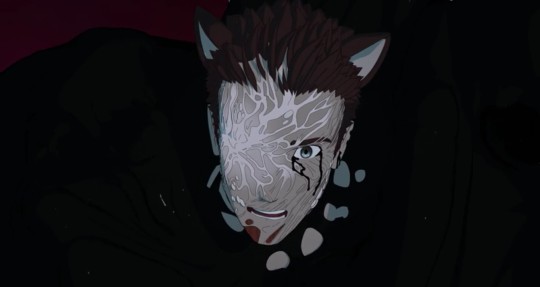
Yup, that's a guy and yup, those are silver eyes.
I would like to issue a formal apology to the "It's secretly Summer!" theorists in the fandom. I mean, I still think it would be ridiculous (and at this point highly improbable) that Ruby's dead mother has actually been a grimm mutant this whole time, just hanging out in Salem's realm while she waits for the plot to start before attacking the world, and then sends some no-name faunus dude after the group instead of their leader's mother for extra, emotional torture... but you all were definitely right about the “It's a person” part! I... don't know how I feel about this. Admittedly, it seems to be a logical continuation of the other grimm-human hybrids we've seen — namely Cinder and Salem herself — and it finally explains why Salem wants Ruby alive (even though it actually doesn't because WHY did she want more SEWs for Hound grimm when she wasn't even attacking back then? And already has all these other insanely powerful tools??), but at the same time, it feels like it's complicating a story that doesn't need further complications. The group fights monsters and has an immortal enemy. You don't need to add 'Some of those monsters are secretly human' to the mix.
It doesn't hurt that this twist is giving me Attack on Titan vibes, which, ew. A dark time in my fandom life, folks.
The Hound staggers a few steps before Whitley and Willow dump a suit of armor on it. That's all it takes to kill the most dangerous grimm we've ever seen: a single flash of silver eyes and some heavy metal. This also wreaks havoc with the implication that Salem wants SEWs alive because they create such powerful grimm. Obviously not. I mean yeah, normal huntsmen are going to have serious problems, we’ve seen that this volume, but any other SEWs nearby will take a Hound out instantaneously. For a villain with so many other powerful abilities — immortality, magic, endless normal grimm, her nifty soup — Salem would be much better served just killing SEWs straight out. Clearly, creating Hounds isn't worth the effort.
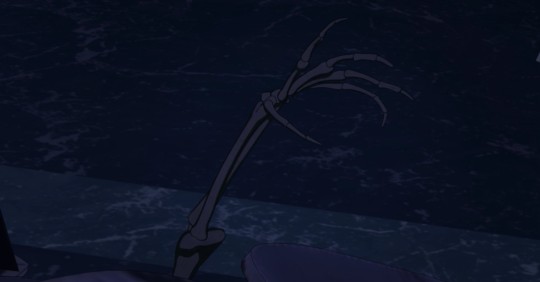

The Hound leaves some bones behind and Ruby collapses to her knees, overcome with the knowledge that this was once a person. Again, uncomfortable Attack on Titan parallels.
We finish our premiere with Cinder clearing away rubble to reveal Watts. Honestly, I like that we ended on this because her rescue is hilarious. She just slings him over her shoulders like a sack of potatoes and blasts off with her magic fire feet. Fantastic.


Note though that with this scene we've seen almost everything from the clip and the trailer. What's to come in the rest of Volume 8? No idea. Outside of Winter leading the charge with the bomb, we got it all here.
Time to update the bingo board!

I'm crossing off "Introducing new grimm that are quickly abandoned." Between the Hound and acid-dude both falling to a single blast/cut from Ruby, we've more than earned this square.
It doesn't look as if we'll get another Watts-Jacques team-up now that he's left, but you never know.
Maria's got me worried. I feel like her Yoda fight against Neo is the one thing she'll be allowed to do this volume, but given that we didn't see anyone except Ruby's group this episode, we don't yet know whether the story is now ignoring her and Pietro, or if they'll re-appear in another episode like YJR.
Qrow is free. Will he get a drink before trying to murder Ironwood? Perhaps.
Still no bingo :(
All in all, the episode was by no means horrible. I think there were lots of horrible parts, but also some legitimately well executed moments, fun action, and scenes that I can easily imagine as squee worthy if you lean back and squint. Everything is comparative and in the growing collection of bad RWBY episodes, this one isn't securing a top slot. Which doesn't mean I think it's good, just... not as bad as it could have been and primarily only bad due to long-running problems, not things this specific episode has done. That's my bar then, so low it has officially entered the underworld.
Still, RWBY is back and a part of me is eager to see where this volume takes us, for better or for worse.
Until next week! 💜
[Ko-Fi]
75 notes
·
View notes
Text
January, 1972
Summary: In Paul's first interview since the breakup of the Beatles, things go slightly awry when a nosy reporter gets more out of him than she bargained for.
Part 1/3 (2, 3)
Paul flashed a blinding grin at the camera, hoping none of the looming anxiety beneath the surface would read. He quickly seated himself in the plushy chair, running his fingers up and down the smooth red velvet of the arms a few times to soothe his nerves. A tad self-consciously, he scratched his jaw, fingers twitching with unfamiliarity against the now smooth skin. This was his first interview in nearly two years.
He had been in a bad way since the breakup. It did no good to mull over it now, but it was hard to stop the same intrusive thoughts from popping into frame—the fuck-all, nothing-matters-anyway attitudes; the gnawing sensation of his own incompetency at the bitterness of feeling utterly lost; the desire to waste his fucking life away drunk out of his mind so he didn’t have to wake up in the morning and remember. What now?
Paul sighed inadvertently, ignoring the curious way the interviewer’s eyes danced over his form. What now? Now, this interview. One day at a time. A nice, simple discussion about the past year—about the success of RAM topping the charts in the U.K. and the slow but steady promise of Wild Life. Family and new beginnings. Peace.
Getting better all the time, right? His stomach did a violent flip at the thought.
Paul jumped a bit as the interviewer leaned forward, brushing a tentative hand across his knee. “Paul? Are you all right?”
Paul blinked. “What?”
She lowered her voice a bit, eyes flicking in the direction of the cameraman. Paul felt dizzy as the red light blinked back at him. “Should we—should we cut?”
Shit. Already off to a poor start.
Slowly, Paul came to his senses, breathing returning to normal (though he hadn’t realized it had been erratic). His chest felt tight as he gave a curt, polite nod, forcing a smile that, to him, felt borderline grotesque.
“No, love. Everything’s fine. Just a bit distracted, is all.” He shot her a wink, hoping to assuage her. Maybe a bit of flirting would do the trick.
He sighed in relief as the reporter flushed, a pleased grin sneaking onto her otherwise hard features. “Right. Well, if you’re ready, we can begin.”
“In earnest,” he beckoned, waving an inviting hand in her direction.
—
Half an hour later, Paul’s face felt utterly plastic from faking so much interest and expression. The poor girl was trying, for Christ’s sake, but Paul had to actually hold back groans at some of the painfully bland questions. Every goddamn thing reminded him of the Beatles, anyway, even if it had nothing to do with them. He felt surrounded by ghosts: the echo of George’s laugh, a flash of fangs; the dissipating vision of the way Ringo bit his lip real hard and furrowed his brow when asked any remotely difficult question; the trace of John’s fingertips on his arms or lightly thumping the back of his head. Things hadn’t been the same for a while, now, as far as those things went; but it was almost like they’d never changed. Everything was rushing back to him as if he’d just woken up from a long nightmare. Only to find that the nightmare was more pleasant than reality, of course.
Paul swallowed hard, fighting the urge to be sick. He wasn’t ready for this.
He wished Linda was there. Paul nearly kicked himself for agreeing to do this alone—he wasn’t sure why they had requested that, anyway, if they were just going to make him repeat the conception of “Yesterday” all over again. He needed her there, needed to distract himself by caressing her and leaning on her and whispering subtle inside jokes in her ear at inappropriate times. He needed to have her, just like—just like he needed—
“On your newest record with Wings, you have a particularly interesting track I’d like to touch on,” the reporter was saying, bearing down on him with a sudden insatiable gaze that should have been frightening, if Paul had literally cared one bit.
“Hmm?” He replied, noncommittedly.
“’Dear Friend’. It’s about John, no?”
Paul tensed.
The interviewer stared back at him, daring him to speak, the lust for truth plainly evident in her eyes, and Paul swiftly understood. Everything had been mere formalities or trust-building exercises up to this point. Everything to get him here: trapped, with nowhere to go, no one to turn to. His mind worked quickly, frantically, pushing the blossoming anger aside to make room for the desperate bid to save himself. He could only think of one solution, and one he was king at.
Paul began to laugh. Not loudly, not absurdly; just casual enough to where the audience would soon be able to read the feigned perplexity in his tone. “John?” He practically scoffed, cocking an eyebrow at the woman with a look that bordered on condescending. “No, love, it’s not about John.”
“Who’s it about, then?” Came the follow-up.
Paul answered too quickly. “Linda.”
“Ah,” the interviewer affirmed, leaning back in her chair slightly. “I see. So the bit about throwing the wine—”
“Celebration!” Paul interjected, his voice much too shaky for it to ring true. “Throw back the wine. Congratulations, and all that.” He mimicked a drinking glass. “Young and newlywed.”
“Mm.”
Paul’s heart was hammering in his chest, so violently he was sure the cameras could see it. He never should have put out the song. He had knownit was too transparent, but had convinced himself it was his own paranoia. The public was desperately searching for anything to drive the wedge between him and John deeper—even if the song really wasn’t about him, they would have found a way to make it so.
So, that’s what the story was. He felt a sudden angered hopelessness, offended by the audacity of the reporter. To coax him out of practical hiding, persuade him to do this huge press event for the “good of his album”, to pull him from Linda and thrust him into the spotlight he tried so desperately to escape, all so they could catch a hope of getting Paul to contradict and expose himself? Like she was some kind of Pharisee?
He could see her eyes working coldly, calculatedly, and he felt the sudden urge to run. His mouth felt sour, tongue acidic against his teeth that were clenched far too hard to be healthy. He had to get out of here.
“You say friend,” the interviewer started, almost cautiously.
“She’s my best friend,” Paul argued.
“What about the fear? What is Linda afraid of?”
“It’s a general fear,” Paul retorted, almost pouting, feeling more than fed up with the increasingly dangerous questions.
“Is what ‘true’, then?”
“All the things he said, of course,” he snapped.
It wasn’t until she responded that he realized his mistake. “He?”
Shit! Paul’s eyes shot wide as he stumbled for an answer. “I-what?”
The reporter narrowed her eyes. “You said ‘he’. All the things he said.”
Paul’s heart was in his throat. He struggled to breathe, mimicking the feeling of having your head barely above water as the ocean closes around your neck. “I most certainly did not.”
“But you did. You said, ‘all the things “he” said’. I presume you’re referring to Lennon’s more public digs, especially in response to RAM. He's far less subtle than you, you know. ‘Too Many People,’ though, that one’s about him to anyone who has ears to hear it and a brain to really listen. So he comes back with ‘How Do You Sleep’, and though you’ve been sitting on this one for quite some time, it feels right to put it out, a spitball to his face, an olive branch in the face of his fire. It doesn’t matter that it sounds like it’s to a lover. Because, in a way, it is—"
“No!” Paul all but cried out, wanting to press his palms so far into his ears that it would crush his skull. The beginnings of desperate tears well up inside of him. “No, that’s not—I’m not—”
“What happened in India?”
Paul froze.
The reporter simply stared back at him, almost expressionless. Paul’s brain had short-circuited at the question, leaving behind nothing but a dull buzz, his thoughts as comprehensive as television static. The buzzing of the studio lights was the only sound for a long time, save the soft pants escaping Paul’s lips as his chest constricted with the effort of not hyperventilating. When he finally spoke, his voice was dripping with a malice that shocked even himself.
“What the fuck do you know?”
Even the interviewer looked momentarily taken aback. She licked her lips almost hungrily. “Is there something to know?”
“No. It’s—nothing happened, all right?”
“That’s the trouble, isn’t it?”
“What? No!” Paul was astounded, flabbergasted, so far past the point of shock he no longer had control over his ramblings. “Or—no. I don’t know. Nothing happened, it couldn’t—”
“Did you want it to?”
“He wanted—”
“What did Lennon want, Paul?” There was an edge to the reporter’s voice, a twinge of excitement at what may be perhaps the biggest story since their breakup.
Paul said nothing. He couldn’t trust himself to speak. A cloud came over him, blurring all thoughts of past and future. All implications and consequences. He was blissfully, numbly empty.
“Paul McCartney, were you in a… a physical relationship with John Lennon?”
The question went unanswered. He simply stared at the woman opposite him, cool and stony. He could tell by the slight waver in her expression that his intent was evident. It was a dare—turn the fucking interview off, or sit here in silence for the remaining half-hour. Give the viewers quite a special.
Her choice.
Eventually, the woman cleared her throat and shuffled the stack of notecards in her lap that Paul hadn’t noticed until now. He let his gaze trail over her lazily as she made to signal the camera cut. As soon as the little red light went dead, she shot Paul an aggravated glare and shuffled off the set.
He only winked, feeling much more hollow inside than before.
#the beatles#beatles fanfiction#paul mccartney#john lennon (mentioned)#linda mccartney (mentioned)#george harrison (briefly mentioned)#ringo starr (briefly mentioned)#interviews#confessions#songwriting feud of the seventies#beatles breakup#part 1#part 1 of 3
9 notes
·
View notes
Text
“If any character in English popular culture stands for the sheep, it is Griselda. Her chief detractor is, not surprisingly, the shrew. In Robert Snawsel's A Looking Glass for Married Folks, Eulalie preaches the Griselda gospel to Xanthippe and Margery, urging them to bear their husbands' blows and drunkenness with meek loving kindness. This is too much for Margery: "Are you a woman, and make them such dish-clouts and slaves to their husbands? Came you of a woman, that you should give them no prerogative, but make them altogether underlings?" Margery's scornful reference to slavery goes to the dark heart of the Griselda myth. Folklorists have argued about the ancestry of the famous tale for more than a century.
William Edwin Bettridge and Francis Lee Utley have made a strong case that Griselda owes her features to a folktale from medieval Smyrna called "the Patience of the Princess." A prince buys a poor girl from her father and lays a wager with her that she will not be able to submit to all his demands with utter composure. The prince shuts her in a tower alone and tests her for twenty years, repeatedly impregnating her and then taking away her newborn infants, telling her that he is going to kill them. She builds a mother doll out of clay to talk to and cry to but never loses her patience, and in this way she wins the bet.
The tale, which matches the European narrative more closely than any other yet found, throws into stark relief the specter of female sexual slavery that haunts Griselda's story. The most striking variance between them is that the girl from Smyrna is sold into involuntary servitude by her father, whereas Griselda has a choice and agrees to voluntary and total obedience. Passing into European culture, the story came to Boccaccio. In reworking it for the Decameron he reclothed it in local garb, fashioning his novella partly in terms of Italian wedding and dowry customs that were sharply weighted against brides and wives. Boccaccio thought Griselda's story significant enough to give it pride of place as the last tale on the book's final day of storytelling.
Petrarch read the novella and converted it to an exemplum in Latin for male scholars. Griselda entered English culture through Chaucer's "Clerk's Tale," which is largely based on Petrarch's version. Plays, ballads, and pamphlets on Griselda issued forth on the continent and in England throughout the early modern period, with a cluster of publications and performances in the mid- to late sixteenth century. Arguably the most radical change between versions occurred when Petrarch reworked Boccaccio. The Decameron's final tale is told by the satirist Dioneo, a crucial choice by Boccaccio. Refusing to let the happy ending stay happy, Dioneo spells out the political import of the story and caps it off with a horn joke against the marquis:
Everyone was very happy with the way everything had turned out ....Gualtieri was judged to be the wisest of men (although the tests to which he had subjected his wife were regarded as harsh and intolerable), and Griselda the wisest of them all ....What more can be said here, except that godlike spirits do sometimes rain down from heaven into poor homes, just as those more suited to governing pigs than to ruling over men make their appearances in royal palaces?
Who besides Griselda could have endured the severe and unheard-of trials that Gualtieri imposed upon her and remained with a not only tearless but happy face? It might have served Gualtieri right if he had run into the kind of woman who, once driven out of her home in nothing but a shift, would have allowed another man to shake her fur to the point of getting herself a nice-looking dress out of the affair.
Scholars often downplay Dioneo's bitter words about pig-tending and his final putdown of Gualtieri, attributing it to his cynicism; but their labors to match the tale's disturbing sadism with an uplifting exemplary meaning are less than persuasive. The passage is much more than a glib throwaway, as Edward Fechter points out: "the climax angrily repudiates theological allegory and exemplum." Certainly, it seems fitting that the last lines of the last tale in the Decameron should recapitulate the Boccaccian theme of cuckoldry as female revenge. Dioneo's parting shot about "the shaking of the fur" is also an invitation to his listeners and the book's readers to come up with better interpretations than do the silly sheeplike courtiers of the tale, who judge "Walter wise and Griselda the wisest of all."
Furthermore, it is a jest that asks for scornful laughter, especially from listeners who have grutched throughout the tale at Walter's arrogance, egotism, and sadism. Petrarch told Boccaccio that the story so fascinated him that he decided to spread the tale to scholars abroad. So "snatching up my pen, I attacked this story of yours." The angle of Petrarch's attack on the novella (which he termed "a little too free at times") becomes manifest at the cuckoldry-free conclusion of "A Fable of Wifely Obedience and Devotion," in which he erases Boccaccio's satire and his bawdy call for female revenge:
This story it has seemed good to me to weave anew, in another tongue, not so much that it might stir the matrons of our times to imitate the patience of this wife-who seems to me scarcely imitable-as that it might stir all those who read it to imitate the woman's steadfastness, at least; so that they may have the resolution to perform for God what this woman performed for her husband ...Therefore I would assuredly enter on the list of steadfast men the name of anyone who endured for his God, without a murmur, what this obscure peasant woman endured for her mortal husband.
Petrarch's straight-faced version has none of Dioneo's political satire or irony. He is writing in Latin to male scholars, not in vernacular Italian to women and men, as Boccaccio had done. Nonetheless, it is Petrarch that Chaucer credits by name in the vernacular, mixed-audience "Clerk's Tale," although he departs from Petrarch in crucial ways. The Clerk does follow his source in insisting that his moral applies not to wives but to all humankind: This storie is seyd, nat for that wyves sholde Folwen Grisilde as in humilytee, For it were inportable, though they wolde; But for every wight, in his degree, Should be constant in adversitee As was Grisilde .... (I 142-47)
Chaucer actually intensifies Petrarch's warning that wives should not try to imitate Griselda, calling her example "inportable," or unbearable. (The Merchant, whose turn comes next, blatantly ignores this caveat, complaining "Ther is a long and large difference I Bitwix Grisildis grete pacience I And my wyf the passyng crueltee.") Still, scholarly attempts to align Chaucer's Walter with God do not work because Walter is described as "tempting" his wife, a word almost always associated with sin and vice. In another departure from Petrarch, Chaucer's Clerk breaks in several times to condemn the marquis. After Walter first decides to try his wife, the Clerk interjects hotly what neded it Hir for to tempte, and alwey moore and moore, Thogh som men preyse it for a subtill wit? But as for me, I seye that yvele it sit T'assaye a wyf whan that it is no nede, And putten hire in angwysshe and in drede. (45?-62)
Chaucer's version subtly calls Grisildis's ovine quality into question. The lamb of God is Christ, of course, and Grisildis' meekness when her daughter is taken away resembles his suffering: "Grisildis moot al suffre and al consente, I And as a lambe she sitteth meke and stille" But "moot" she? Within English popular culture, sheep and lambs do sometimes stand for the positive values of resignation and endurance-for example, in emblems on patience. But there is no doubt that sheep generally connote passivity, cowardice, and stupidity. In terms of sheer frequency, the negative secular connotation overwhelms the positive religious one.
A related complicating effect is the criticism leveled at "the unsad" (that is, fickle and sheeplike) people of the realm, who at first deplore Walter's acts but change their minds when they see the pretty new queen (actually his daughter), leading "sadde folk" to exclaim: "0 stormy people! unsad and evere untrewe!" As the Clerk finishes his tale, he shows that he is fully aware that not all his listeners will appreciate Griselda's virtues. With teasing wit he acknowledges the Wife of Bath, who has been called the tale's motivating force and dialogic counterpart. Just before the comic envoy he promises "for the Wyves love of Bathe" to gladden her "and al hire secte" with a song urging them to ignore Grisildis and revel in shrewdam (rr69-74).
By shifting the Clerk's role from that of the preacher of a pious exemplum to a merry jester-singer, Chaucer undercuts his clerkly authority and blurs the moral legibility of his tale, already obscured by Griselda's lack of moral agency and her husband's viciousness. Nonetheless, Griselda quickly proved alluring to husbands, and she retained that allure despite proving highly problematic as a pattern for wives. Like the new husband in the jest about the pottage, men who wanted very much to promote Griselda as a model found her too hot to handle.
In the training manual he prepared for his young wife in the 1390s, the Menagier de Paris offers a confused and troubled account of why he wants her to learn about Griselda. He rushes to assure his wife that he'll never torment her "beyond reason" as the "foolish, arrogant" Walter does Griselda, nor does he expect such obedience: I have set down this story here only in order to instruct you, not to apply it directly to you, and not because I wish such obedience from you. I am in no way worthy of it. I am not a marquis, nor have I taken in you a shepherdess as my wife. Nor am I so foolish, arrogant, or immature in judgment as not to know that I may not properly assault or assay you thus, nor in any such fashion.
God keep me from testing you in this way or any other, under color of lies or dissimulations …I apologize if this story deals with too great cruelty-cruelty, in my view, beyond reason. Do not credit it as having really happened; but the story has it so, and I ought not to change it nor invent another, since someone wiser than I composed it and set it down. Because other people have seen it, I want you to see it too, so that you may be able to talk about everything just as they do.
What he really wants, it seems, is for his wife to be au courant. Griselda had "much currency off the page as a talking point in the late fourteenth century" and was "a subject about which wives might be expected to have an opinion." Codified as a way to get women talking (instead of shutting them up), the narrative about testing is itself a means of testing a woman's opinions and conduct. Is Griselda sick or stoic? Enslaved or free? Is hers a saint's tale, with Walter an abstract tool in the central mystery of her endurance, or is it as much a story about Walter and his court? Is he a cruel tyrant or a stern but loving husband with every right to test his wife? Is Walter God and Griselda a female Christ or Abraham or Job? All these positions have been argued during the six centuries of the debate.
Some recent readers still find Griselda admirable and even question whether she should be regarded as a passive victim. Harriet Hawkins has argued that Chaucer's tale should be read as a criticism of unquestioning obedience to authority, even divine authority, while Lars Engle hears "an implicit voice of sane moral protest" in Grisildis's mild objections to her husband. Such strained attempts at recuperation show that Griselda disturbs more than she edifies, raising but failing to answer questions about the limits of obedience in the face of tyranny and the conflict between Christian duty and wifely subjection.”
- Pamela Allen Brown, “Griselda the Fool.” in Better a Shrew than a Sheep: Women, Drama, and the Culture of Jest in Early Modern England
4 notes
·
View notes
Text
Kill la Kill Does Not Have a Happy Ending.
Finally completing the story mode in Kill la Kill the Game: IF has inspired me to make GIFs again, so I’ve been listening to and/or watching more video essays than usual lately.

What can I say? Editing GIFs when you don’t have fancy programs is... a little bit tedious. It’s nice to shove your attention towards something else while you paste the same text onto 100 different layers.
But anyway, there’s this bit at the end of Lindsay Ellis’s “Woke Disney” video that got me thinking:


Ellis: Are you that guy in that Onion article that always likes to bring up that John Lennon beat his wife?
Mostly, I got to thinking about my feelings regarding the popular fall 2013 anime Kill la Kill... and how endlessly, endlessly salty I am about its conclusion.
“Am I that guy?” I wondered. “Do I get some kind of sick joy out of telling people who loved and resonated with this silly show’s finale that no, actually, what we got was an absolute tragedy?”
And my questions for myself didn’t stop there. “Why do I feel the need to rain on everyone’s parade?” I thought. “Why am I such a party pooper about all this?”
In the end, I don’t know if I have a good answer. But I do have reasons for my constantly reiterated salt, and they basically boil down to this:
✄ Killing one character so that another can undergo character development, or to signify maturity, is a common storytelling trope... but that doesn’t mean that it’s a good storytelling trope, even if it “makes sense” or “works.”
✄ Though much of its content was cut from the final show, early ideas for Senketsu’s character involve a heavy oppression narrative much in the same vein as other Kazuki Nakashima-written anime like Promare and Brand New Animal, and elements from those concepts are clearly present in the finished anime. Senketsu is told repeatedly that he’s a monster and no good for Ryuko, Ryuko is initially embarrassed to be seen with him because of how society will perceive her for it, and Senketsu’s arc is one of self-love. He’s not just an object; he’s a person, and his thoughts and feelings matter. Everyone can hear his voice in the end because he realizes this. To kill a character who is demonized and “othered,” whose growth is about respecting himself and understanding that he has worth, is not at all a happy ending or what’s “best.”
✄ Senketsu is not a wise mentor figure nor a replacement father for Ryuko; he is constantly emphasized to be her equal and partner and literally has no life experience to guide anyone with, his eyepatch has been stated by show staff to exist because it’s supposed to symbolize that he still has room to grow (just like Ryuko!), and a “man” showing a woman love and respect does not automatically mean that he’s her parent, especially when their relationship has a level of intimacy that would be horrendously uncomfortable between a father and a daughter.

Ryuko, to Senketsu: Nah, it’s cool. It’s not like ya cheated on me or anything.
✄ Similarly, Senketsu is his own person. Ryuko growing close to Senketsu is not her growing close to her late father. It’s her growing close to a friend who has been thrown into the same cruel situation that she’s been thrown into. Senketsu does not deserve to die for Isshin’s sins. Someone who has not lived even a year does not deserve to die purely because he was created by a man who had a strained relationship with his daughter.
✄ For a series to consistently stress that two people from different groups can get along and love each other, even when the entire world tells them they can’t, and then end by saying that one is actually better off without the other... is both a contradictory message and one that, intended or no, smells a little like an argument against diversity.
Of course, I recognize that this all sounds very dramatic. And I assure you, I understand that I am the most dramatic.
But I believe in the power of stories. I think they’re important. I think the messages they send and the arguments they make, and how these messages and arguments are interpreted by audiences, say a lot about our world—and this is particularly true when it comes to stories as widespread and discussed as Kill la Kill!
So, when I see gushing about how happy the ending of this ridiculous anime is? That Senketsu absolutely had to die because he’s nothing more than a metaphor for menstruation or puberty? That he’s a parent, and adults have to let go of their parents eventually, so there was no other narrative choice but for him to kick the bucket? That it’s “for the best” that he goes because something like him could never have a place in the newly peaceful world?
Well. I find it all hurtful. Incredibly so.
There are certainly valid complaints and criticisms about fantasy depictions of “otherness,” and it’s certainly a valid critique to find the reason behind Senketsu’s eyepatch—that it’s meant to represent how he’s “still imperfect, with room for improvement and evolution”—dishearteningly ableist. But Senketsu’s story and growth with Ryuko are a lot of what make Kill la Kill so important to me. To see these two young adults finding themselves, as equals and partners, when people can’t stop telling them that they should be enemies? To see them ultimately save the world together with their friendship and love? It’s why I’m writing any of this at all. It’s why I’ve ever written anything about this series ever.
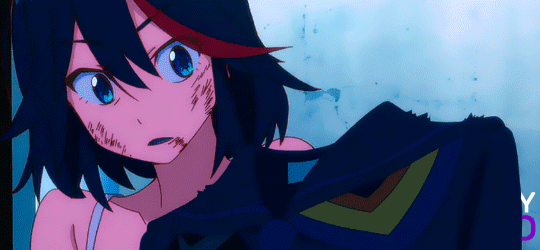
At the end of the day, I’m not here to tell anyone that their interpretations of a fictional story are “wrong” or that mine are “right.” Nobody is a “bad person” for how they read a television series, and it’s completely fair for anyone to find my own interpretations of this show and its conclusion offensive, too.
But to answer my initial questions, I don’t talk about my discontent with the ending of Kill la Kill and its most agreed-upon readings because I get a rush out of telling others that it’s sad. I talk about my discontent because I don’t think the harmful implications I see should be ignored.
I don’t like seeing the assertion that the death of a character who is repeatedly referred to in canon material as Ryuko’s “precious partner” is “for the best.” I don’t like that the Kamui Bansho, the official Kill la Kill guidebook, literally describes Senketsu as Ryuko’s “one and only ‘partner,’” and yet there’s the argument that he’s nothing more than a metaphor, a father who has power over Ryuko and must die to let her live on her own. I don’t like how writer Nakashima outright states in that same guidebook, “You could say that Kill la Kill tells the story of a lonely young woman meeting and losing an irreplaceable partner,” that the Word-of-God explanation for Senketsu’s death is that it bookends the story, that Toshihiko Seki, Senketsu’s voice actor, similarly describes the anime as a tale that begins from “the meeting of a lonely person (Ryuko) and a lonely existence (Senketsu),” and I don’t like that there’s almost anger when the ending in which this partner dies is accurately called a tragedy.
I don’t like the idea that someone who helped save the world would have no place in a time of peace because he’s “different.” I don’t like that a “man” being nice to a girl is construed as fatherly, especially when said “man” has hardly had a chance to live at all. I don’t like the sickly feeling I get that none of these arguments would be argued had Mako, Ryuko’s other precious partner, died instead. I don’t like the sickly feeling I get that a person’s physical appearance defines so much of their worth.
In the past, I’ve been chided for expressing my displeasure. “Stop playing the victim,” I was told, when I said I dislike the notion that Senketsu’s death is “for the best” because such a notion subtly communicates to me, an unattractive person, that an unattractive person dying is okay. A happy ending.
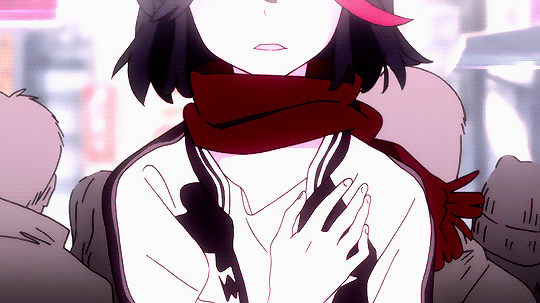
But I think it’s important to voice our displeasure with story decisions and the readings of them. I can’t speak for anyone else, but I want stories that are more respectful. I don’t want to constantly see characters who are “different” dying less than five minutes before the end, and I don’t want to constantly see the argument that this is “good” because they helped further another character’s growth. I want characters who are “different” to be able to continue growing with the people they love.
Will I be writing stories more to my taste myself? Absolutely. But maybe by talking about these things, I can help inspire others, too.
#kill la kill#senketsu#ryuko matoi#analysis#spoilers#klk spoilers#ramblings#shut up goop#klk ending salt#gifs i made#i hate this essay so much i spent like six hours trying to not make it a wall of text and managed to make it a wall of text anyway :P
32 notes
·
View notes
Text
August ‘20
Ruiner

Ruiner frames its action at an isometric tilt. There’s a lot of red; in the game’s interface, as the prominent colour of the neon lighting that adorns its stages, and in the blood that is frequently spilled. Its cyberpunk setting isn’t anything particularly new, but as a unifying aesthetic, the glitchy effects, and out-there personalities doing their best to cope in a dystopia do well to build a convincing and intriguing world. Stages are action packed and throb with electronic noise and big loud industrial bass hits, with the play being akin to an arena shooter; enemies surging at you in bite size, minute-at-a-time waves, with each of these closing out with a grading screen serving as the pat on the back to keep that dopamine rhythm pulsing. It’s a pretty hypnotic cocktail.
These stages evolve out of a singular hub city, and while it’s not particularly big, there’s just the right level of hubbub, and it has a lovely Hirusawa Susumu track acting as an excellent, melancholic mood-setter. Based on the size of its world and the the quick-fire action being split between a very small number of stages, it’s not surprising to say it’s fairly brief - I mean, how could it get so big? But what is important is that it’s plenty of fun and and has style by the bucketload. I got a good kick out of it.
Carrion

On one hand, a horror game where you play the horror is just the kind of flip on a genre that’s needed to freshen things up a bit. On the other, it’s one straight out of the spoof ‘Peter Molydeux’ playbook. What a carri-on.
... I’m sorry. After your initial escape from a lab, Carrion centres around a hub world, with individual stages then breaking off to allow for more specific themed stages. What you’re trying to do within these is to spread your big, goopy self around, where certain spots will act as save points but also count toward unlocking an alternative path back to the hub and opening up new routes in the process. What’s unique to this particular metroidvania take is that while there are new skills that open up new routes, your movement in general is uniquely freeform - point in a direction and off you go, free of any worries about platforming and the gravity that’d otherwise bind you. While it may not be the most precise movement given the size to which you grow - and boy does this become a point during some forms of combat - it does remain responsive, and quite fun to simply shamble about like a giant congealed blob of bloody, multi-toothed sinew-y mess. Everything scales up nicely on both sides of the fighting, with distraught pistol-equipped humans turning to shielded folks with flamethrowers, all the way up to drones and mechs that are just as mobile and / or deadly as yourself, even in spite of your own upgrades that allow for more ranged, varied, and sharper extremities. It’s not especially long, and is never so taxing as to demand too much expertise of you, but it is fun and importantly, quite unlike anything else out there.
Yoku’s Island Express
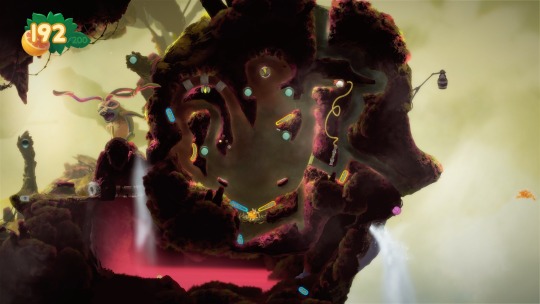
Pinball continues to feel like a lost art form to me, with the nuance of skilled play being more like a foreign language than another type of game you can easily pick up. Yoku, newly-appointed postmaster, is but a tiny little bug, and as such is indebted to these skills in his efforts to travel and clamber about an environment much larger than he. Flippers are casually littered about to shoot you from one area to the next, but there’s also plenty of sections you’re led to by the story that are small yet just detailed enough to play like a neatly sectioned off area of a complete table - complete with requirements for precise shots to move forward, and those inevitable moments where you have to sit back and watch as your ball falls with miserable, exacting precision between the flippers. Failure typically sets you back a few pickups, but given these are just as quickly re-earned, you’re never punished too hard - there’s certainly no three strikes and out mentality here. It’s a very friendly interpretation of pinball’s mechanics, and there’s a decent enough story layered on top, with its characters and art demonstrating enough pleasant charm that you can definitely see this being a great way to introduce pinball to a younger audience. That’s not to say it’s not enjoyable from an older player’s point of view - just that you know what’s being presented is a wisely palatable version of a classic hobby, rather than the arse-kicking ordeal you may be used to.
Rime

I am certain that Rime would love me to compare it to a certain Fumito Ueda PS2 game. There’s the ultra-minimal scene that’s set as a boy washes up on an island; a sparse, beautiful, somewhat Mediterranean set of landscapes, and with very few ways to interact with it all that don’t involve clambering over things or shouting out in wordless desperation. But as you’ll have noted, I haven’t found it in myself to justify using that game’s name here.
As much as I wanted to give this a chance, it often felt directionless, uninspired, and at worst, slow and tedious. The puzzles are derivative of any number of games I’ve played before, and the biggest danger is that you might assume as to their difficulty and over-engineer your approach, rather than not be able to tackle them. The platforming is simplistic and regularly drawn out with ledges, ledges, and more ledges to climb across and dangle from; even if you were to find a way to fall to your doom, as is tempting, it is unlikely to take you back much further than a few seconds. Crucially, there’s really very little to sink your teeth into on any front, and even when the game does finally start to weave some plot threads into the game’s canvas, it’s well into the latter half - long after I’d already racked my brains for any hint of an allegory that’d fit, and given up on expecting one. Sadly, to the point that the actual story felt like a cheap afterthought when it did finally start to unravel. This bounced off me much harder than I’d expected - I came away wishing it had forged a bit more of an identity and a purpose rather than just an aesthetic strung together with some weak elements of play.
If Found

As far as interactive elements in visual novel-type games go, If Found has a different approach to most. The story’s primarily told by means of a diary - one that’s full of witty observations, personal reflections and enigmatic sketches - that you actively erase as a means to push events along. The diary belongs to Kasio, a trans girl returning to their small Irish hometown after a stint away at university in the city; a return that’s not met in the warmest or most understanding fashion. As a mechanic, the erasure of this diary is loaded with meaning; peeling back layers of a scene often matches a more poignant set of observations, and the scrubbing of such personal details away offers a painful reflection on an identity being chipped away at. It’s very much a story about finding one’s self, about coming of age, and as it rides these highs and lows it does an excellent job in making you ride along these alongside the characters, and it does one hell of a job to make you think about the compassion that you both see and offer in the world outside. I’ll put my hands up and say that there are some elements of the story running in parallel to this main one that didn’t gel with me quite so well, but this is a minor footnote to an otherwise highly enjoyable play through. In a short space of time, Annapurna have done a great job in winning me over with their publishing choices - particularly in holding up the kinds of voices and ideas that fit these smaller titles so perfectly.
Double Kick Heroes
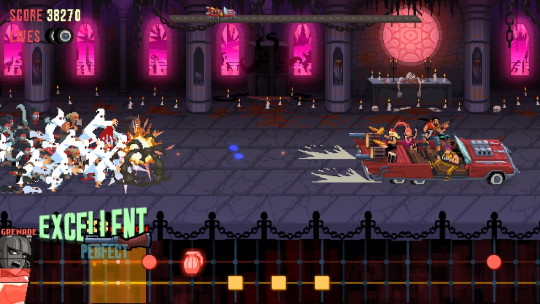
It’s a rhythm game. I like rhythm games! It’s about a zombie apocalypse. Oh no. It’s... a heavy metal rhythm game? Ok, maybe we can work with this.
After a trailer name dropping a bunch of familiar artists - Jinjer, Carpenter Brut, Gojira - what surprised me straight off was that none of these licensed artists featured in the game’s story mode. They’re all sectioned off in a separate menu, and while on the bright side they’ve each given a unique stage with a visual theming in keeping with the bands in question, it feels like a bit of a missed opportunity. Instead, all tracks throughout the story were composed by just one person, and with only a small handful of featured musicians being included to diversify things. It starts with more (arguably) palatable hard rock numbers, but goes up to and includes grindcore, death metal, black metal and the like, meaning that not only is it going to put a lot of folks off right away, but that it’s asking a heck of a lot for one composer to cover all of these sub-genres with the appropriate care. While it was refreshing to hear some types of music I’d normally not expect to hear in a game, some tracks inevitably grated, and while I enjoyed some others, I wasn’t ever bowled over too strongly either.
The story itself is fairly by the numbers. It sees an on-tour band fighting back against a zombie uprising, and has unsubtle references to any number of heavy artists, albums and songs shoe-horned in at every opportunity. It also bears the hallmarks of its dialogue being written by someone that has a very particular sense of humour which personally all fell very flat. While the team undoubtably do love music, the over-enthusiastic style rubbed me in a similarly uncomfortable fashion as Jack Black does regularly, with his half-comedian, half-musician schtick. The gameplay itself is based around the drum parts of its songs also corresponding to different weaponry on your car that holds the hordes back, and while this on its own can prove tricky, higher difficulties also mounts other expectations - like steering your vehicle, or alternating pedals to shoot different parts of the screen. Some of my frustration with all of this is likely my own fault for having chosen to play on the ‘Hard’ difficulty, but traditional wisdom feels a little bit lost when you can still get damaged when your combo meter is racked up well into triple digits.
In all, Double Kick Heroes presented some pretty unique gaming scenarios; like having to work out the best controller configuration to play blast beats with, or asking out loud “did I just hear the words ‘we are Genital Absolution’ coming from a Nintendo console?”, and it’s clearly a small team working on something they really care about. I respect that. I didn’t enjoy it as much as I was hoping, but I hope they’re proud of what they’ve created.
Manifold Garden

A puzzle game taking significant inspiration from the works of M.C. Escher is a pretty good starting point in my eyes. It being presented in a wonderful manner certainly doesn’t harm either; from the UI all the way into the game, it’s beautifully clean and defined, opting for delicate shading rather than messy textures, and with its intricate, recursive geometric patterns, you’ll likely find cause to stop and take stock on a regular basis.
One button looks after your basic interactions with the world (pushing, picking up, and so on), with your other crucial way of interacting with the world being the ability to approach a surface and then assign it as ‘the new down’ - spinning everything about an axis, planting your feet to it, and changing your perspective on everything. There’s a nice steady introduction of puzzle pieces as you ease your way in, but they all stem gracefully from these simple mechanics. That I - not the world’s greatest puzzle gamer - was able to enjoy this without every getting too stuck may hint at it perhaps not being as complex as some puzzle fiends might desire, however this amounted to me coming out the other side with great waves of satisfaction, and nought but positives to say. I would go so far as to say that it’s the most fun I’ve had playing a puzzle game in a long, long time, and to boot it’s also perhaps the game where I’ve used the screenshot button the most copiously. Wonderful stuff.
1 note
·
View note
Text
I saw dear evan hansen a week or two ago and like... it was really bad and disrespectful and frankly just in poor taste. and the songs were pretty bland and the production value was mediocre. (yet somehow it won SIX tony awards and anastasia won zero. okay.) it was literally john green but for theater kids. if you don't know the plot, you can find a synopsis on wikipedia, but the gist of it is that one high schooler (connor, who is a Loner Problem Child who Smokes Weed) kills himself, and another high schooler (evan, who is Socially Awkward and Has Anxiety) pretends to have been friends with the now-dead connor in order to ease connor's parents' grief. in doing so, evan ends up becoming popular and well-liked, starts a fundraiser in "connor's memory," and ingratiated himself into connor's family and ends up dating his sister. the whole thing gets taken way too far, as expected, but there are very few consequences for evan's lying other than the occasional self-reflection of "oops, this is bad! I'm in too deep! but I have Social Anxiety and therefore I'm not really responsible for my actions" and the eventual slap on the wrist he gets when the facade comes crashing down. the show as a whole does very little to even attempt to condemn his behavior and there's sort of a wishy-washy "the ends justify the means" air to the whole thing.
there's a lot of stuff I could get into--the toxic faux-family dynamic where connor's parents end up adopting connor as a better replacement of their deadbeat dead son (which the narrative does very little to acknowledge as a bad thing in any way), the trope-typical "shy protagonist boy who feels a vague sense of entitlement/'love' towards this girl he doesn't know, so naturally they end up together as an organic progression of events" (compounded by the fact that evan gets close to this girl by pretending to be a friend of her dead brother. they kiss on her dead brother's bed. like...), the fact that evan's whole charity in connor's memory is founded entirely on lies and is a fundraiser for a cause that has nothing to do with connor (they raise money for an orchard, because evan likes orchards and therefore pretends that connor also liked orchards). we as the audience are basically expected to sympathize with evan, even when (or if) we know what he's doing is "wrong." there's very little exploration of how or why this is "wrong" other than a general sense of "lying is bad." (I could also go on about how the stage production is set up in such a way that social media and giant digital screens form a major component of the set, but the play itself makes basically no attempt to explain how or why this matters, instead expecting the audience to do the mental heavy lifting of "social media is like, bad or something.") but my main qualm lies in the absolutely atrocious treatment of suicide, suicide prevention, and mental illness in general.
connor's suicide is reduced to a plot point. he kills himself unceremoniously within the first twenty minutes of the first act. not once throughout the entire play does anyone wonder why connor killed himself--certainly not evan, who, despite crafting an elaborate fictional account of connor's life and inner world, makes no attempt to actually sympathize with the real actual connor or even slightly question what his real motives or personality were like. his death is one hundred percent just a means of advancing the plot. both in-universe and from a textual perspective, connor is, to be blunt, better off dead than alive. this is obviously a really great message to send in an anti-suicide musical, that your death will just be a catalyst for other, more important events and your own personhood is largely irrelevant. connor is by far the most interesting character in the show, and the show kills him almost immediately. (I will say that they make no mention of the method he uses, which is actually a good thing overall, especially given the show's teen audience and the nature of copycat suicides, but I doubt that it was a deliberate choice to be "tasteful" or anything instead of just a complete lack of attention given to connor's character, so I'm not going to give them a brownie point for that.)
for a play supposedly about suicide and mental illness, it makes very few specific references to any of these things. evan has a therapist who is mentioned, but we never see or hear anything about them--having an on-stage session with the therapist would be tremendously interesting, in my opinion, but the opportunity is missed. evan talks vaguely about some corny journaling exercises that are basically just CBT lite but there's no explanation as to why he does this thing. evan's mom makes an oblique reference to evan's vaguely-defined "pills," to which evan says that he stopped taking them because he's "doing better" now that he's finally Cool and Popular. (this is played straight as a good thing on evan's behalf. no reference to the fact that like, not only are you supposed to taper off meds when you stop taking them, but also that you're supposed to keep taking meds when you're doing well because that means they're actually working. plus the general baggage of associating "going off your meds" with "finally being cured and totally fine now," but I digress.)
mental illness is barely discussed as a contributing factor towards connor's death (to the extent that connor's death is examined in any capacity, which is none). dear evan hansen treats suicide as a result of simply "feeling like you don't belong" and not a culmination of so many cultural, social, and biochemical factors. nor does it ever really define what it means to "belong" bedsides a vague sense of "being popular and everyone likes you." (not to mention that, while connor is portrayed as being vaguely antagonistic towards evan and making evan seem like a defenseless victim of bullying, evan's friend actively taunts connor for no reason and tells connor that he "looks like a school shooter," and we as the audience are meant to find this funny, presumably. yet after connor's death there's no sense that his social ostracization or the failure to address his negative behavior might have contributed to his suicide, just that "oh if he knew how much we all cared, he certainly would still be alive!" because obviously, everyone cared about him, from his classmates who make fun of him to his parents who make no attempt to understand why their son acts out or has behavioral issues.)
the overall tone of the musical is either nauseatingly upbeat or gratuitously twee and sad. the "sad" parts are sort of a torture porn that demand to be seen as So So Sad instead of actually making any emotional impact that could be seen as sad. it reminds me of when the fault in our stars came out and everyone bragged about how much the book made them cry, as if being Emotionally Impacted by the (mediocre) story somehow made you more virtuous than your dry-eyed peers. the whole thing is so fucking self-congratulatory and a way of acting like you care about social issues without doing anything impactful (or in this case, supporting something that is actually actively harmful).
dear evan hansen is actually a very good social commentary on the way social circles and the media at large (both in terms of news reporting and popular culture) treat issues of mental illness and suicide, but this commentary is completely unintentional and metatextual. it's not that it's an actual good critique of these issues, it's that the play is SO BAD that it serves of an example of these harmful phenomena. ironically, several characters within the play as treated as examples of people who are over-the-top in their supposed interest in these things (one girl who has never even met connor makes a show out of mourning him to the point that she pulls a muscle in her chest from crying so hard), but this is more of a comedic element than social commentary. both the audience and the characters turn connor's death into a chance to make a spectacle of their own support and grief rather than to offer forth any sympathy or support for him. when the charity in connor's honor goes viral online and we see shots of people making signs with hashtags to show their "devotion to the cause" (a cause which, to remind you, has nothing to do with connor's actual interests), this is supposed to be immensely touching rather than something between horrifying and laughable. at one point, the letter that evan pretends is connor's suicide note (but was actually a CBT journalist exercise written by evan himself) goes viral. A TEENAGE BOY'S (FAKE) SUICIDE NOTE GOES VIRAL, AND WE AS THE AUDIENCE SEE A BUNCH OF PEOPLE HOLDING SIGNS WITH HASHTAGS ON THEM, AND THIS IS SUPPOSED TO BE TOUCHING INSTEAD OF, LIKE, THE WORLD'S CRAPPIEST GALLOWS HUMOR. I DO NOT UNDERSTAND HOW ANYONE, ANYWHERE, COULD SEE THIS AND THINK THIS IS AT ALL ~DEEP~ OR EVEN LIKE, REMOTELY TASTEFUL.
it's bad. the songs sucked. if you want a musical about social issues among high schoolers,fucking mean girls (of all things) is a genuinely more moving and subtle social commentary, plus the soundtrack and production value are actually good.
#this is long and more than a little incoherent#also i'm sure i missed a lot of things#but like. it's bad. it's probably worse than you would initially assume from the synopsis#suicide///#long post//
30 notes
·
View notes
Text
The Paradox of Oceans
I liked The Shape of Water, but my reaction to it was more thoughtful that ecstatic. It’s more than a Good Film; it is a Beautiful Film, in Every Respect.
It’s not the movie I thought it would be, it is only partially the movie it was marketed as, and I understand how this could get in the way of either seeing what the film is doing, or appreciating it. One of the things del Toro is best at as a director is taking what people typically consider schlock(especially horror), and turning it into deeply sensitive examinations of emotions and the human condition. To Wit: a big deal has been made of TSoW being a “monster-fucking” movie; about del Toro’s interest in a movie where “the monster gets the girl”. Eliza and the Amphibian Man certainly DO get naked for some all-but-filmed sexytimes(Twice no less owo), but it doesn’t end up being the interspecies love-film it was sold as. That’s unfortunate in that I continue to want to see that movie, but irrelevant(to me) in that the movie it IS, is still Excellent. Fundamentally, The Shape of Water is a movie about companionship, and the monster-fucking and romance, such that it is, only works to serve that theme alongside other examples and examinations of intimacy, connection, and feeling. The Shape of Water is, most centrally, about the search and desire for Companionship and Acknowledgement; not JUST to have someone, but to See and Be Seen, to Hear and Be Heard, to Touch and to Be Touched. To be Accepted rather than Denied and Rejected.
Eliza feels the world refuses to see her instead of her disability; that she lives in its shadow. The Amphibian Man is homeless, friendless, surrounded by incomprehensible enemies who refuse to acknowledge him or communicate, who torment him physically and care nothing for his feelings, in the charge of a man who reviles him as an offense precisely because of his difference from him, and revels in the pain and anguish he causes “The Asset”(he is, quite literally, commodified!). Giles feels abandoned and rejected by the one person he thought he had a true connection with -his old lover, a person(I got the sense) he had dedicated years and possibly decades to, but who is determined to remain in the closet, and who asked him to quit his old job at their ad agency to preserve that closeting- clinging to him by the end of a thin, slippery line, desperate to keep that connection alive in a dangerous world now turned upside down where he understands nothing, has no-one(but Eliza) and where anyone, no matter how fair their smile, could secretly revile him for his love. Zelda is locked in a dying marriage with a man who has shut himself off from her, and from all those human connections that are the sinew of any vibrant relationship, because he has given up on himself. Dimitri has left home out of patriotism and idealism to live as someone he is not, with his only lifeline back to his true Self and true Ideals a pair of brutish, criminal fools who care about as little for those things as they do for his safety. All these people are alone. All these people desperately don’t want to be; want a real, reciprocal connection. All these people are reaching out in what variously pitiable ways they have available to them. The Shape of Water is a film that asks you to empathize. It is a film that asks you to reach back. It is a film that asks you to be human.
Which is its central, and powerful, irony, I think, because it’s also a film where the main protagonist, the most humane of them, is very likely not human in the biological sense, though this is only possibly confirmed at the very end. At the opening of the movie we see that Eliza has six “scratches” on her neck, three to each side, that look like nothing so much as gills. This lays down a marker that slowly, very slowly, pays out through the film, as Eliza’s growing connection with AM opens up her life and unlocks her true nature. The film is skillfully cagey about it though; Eliza is associated with water from the opening scenes, starts to show a preternatural affinity for water as the story proceeds(she knows exactly when the rainy season will start, and controls drops of rain on a bus window), but the nature of the film makes you question the reality of any of this. There’s a whimsicality to the film(Eliza’s dancing, the old music, the set design, Eliza’s daily routine montages) which makes the experience of watching it rather Amelie-esque. As a result, I found myself wondering if this was real magical realism, or just the imaginative, quirky, not-really-magical kind so common in movies from the early 00s. But she DOES call when the rains will arrive; she DOES fill a whole bathroom, implausibly, with water in an apartment with rickety walls, flyapart doors, and floors that you can see light through. At the same time(quite literally :p), AM displays truly magical abilities, establishing miracles are possible in this world, and in doing so suggesting yet another connection between Eliza and him. There’s one particular fantasy sequence where the movie suddenly becomes one of Eliza’s dancing musicals for a moment, a part I found kind of jarring and didn’t really like until writing about the film, just now, made sense of it :p :p This isn’t done in such a way that you feel wrong drawing your own conclusions before the end, but the reality of the magic and the unreality of Eliza’s fantasies are kept in such a (non-stressful)tension that it truly remains up in the air until the very end(and even the end is somewhat ambiguous).
Rather than being an interspecies romance, I saw this as a modern child-theft fairy-tale in reverse; a story NOT about the human-child taken by a Witch or the Fairies, but of the “changeling” left-behind(though in this film I’d say there was more of a “separated” or “taken” feel) and their recovery. The typical taken child is forced into a life of drudgery, is insulted and mistreated, denied emotional fulfillment and acknowledgement, finds a way to fulfill these needs with small, similarly oppressed allies, and finally finds her way home through her own pluck and wisdom, the immeasurable help of the seemingly powerless, and sometimes the love of a mysterious male hero of her own age, and from her own world. Eliza walks this same path, but rather than being taken back to the world of humanity, she is taken from it back to the waters she was found in. Eliza not only attains equal acknowledgement and romantic fulfillment in AM, she is “brought home” by him; quite literally healed of the injuries -emotional, social and physical- her forced sojourn among the humans caused her[1]. There are a thousand ways she could have come to be “lost” among the humans, but that she is “found” through her journey with AM and brought to a place and belonging she recognizes as “home” was, to me at least, unmistakable.
And it is equally unmistakable, given the central position of Companionship and Connection, why the villain is who he is, and why that person is considered the true “monster” by it. Strickland(as wonderfully named as he is played by Michael Shannon) is a man who has built his life around rejecting others, and any attempt at real connection they make. He is the classic “1950s Man”: obsessed with Male Will and emotionally dead by choice through its application; valuing only those relationships which can advance his career or ego; taking pleasure only in the practice and display of power, and the ability of that to humiliate others. Strickland is a man who can never truly be home because he rejects the idea of home, of belonging, of ever being so “weak” as to care for or need another person. And this emotional deadness -which the movie aptly shows is a choice, done by his own hand(there’s even a scene of him reading The Power of Positive Thinking which is not only a wonderful skewering of the character’s type and his era, but also of the US’s current president; Donald grew up in the church of the vile conman who wrote that book)- is just as aptly shown to be his REAL weakness and true undoing. He never suspects that Eliza and Zelda, mere “piss-wipers”, could have had anything to do with AM’s escape, instead chasing the fantasy of a Soviet Strike-Team; he focuses so much on his career and gratification, and is so willfully oblivious to his own body(scarfing his pain-pills just as greedily as his candy), that he doesn’t notice that two of his fingers -recently bitten off by AM and surgically reattached- are going gangrenous. The audience sitting in the theater watches them redden, turn purple, turn black, but he doesn’t take notice until almost the end of the film. There’s a particularly symbolic scene involving them where he tears the fingers off solely for effect, for no better purpose than to frighten and intimidate, driving home absolutely how self-destructive, and ultimately disdainful of self and life, this man and his inhumane philosophy are.
TSoW was also a rather religious movie, thematically, which surprised me since none of the reviews and reactions to it that I’ve read brought this up. The Bible is a thin but strong line within this film; the Old Testament textually, and the New more in theme and by reference. The story of Sampson and Delilah is brought up twice at important moments. The film closes on a reference(I’m pretty sure) to the Song of Songs(though maybe it’s Psalms). Strickland’s hatred of AM is driven by the conviction that humans are made in god’s image and AM is not, making him an “affront”(to what Strickland doesn’t say, but I would argue to himself, which is the only “god” Strickland cares about). The obvious idolatry of this, the transformation of the human form into the divine(and the philosophical relation of that thinking to Olympian philosophies, it should be said), is totally missed by Strickland, as it tends to be by Christians; the movie is openly disdainful of his position. AM can heal injury, rise from the dead, and(possibly, depending on how you read the ending) resurrect others; actions clearly analogous to Joshua’s miracles. Strickland sneeringly mentions that the humans who lived with AM “worshiped him as some kind of god”, as evidenced by their leaving such “divine sacrifices” as... food to eat, and plants and stones that he found beautiful near the lagoon they pulled him from. I found myself wondering if he felt beatified by being invited to a neighbor’s weekend grillup. At the end of the film, seeing AM rise from the dead, Strickland, in horror, says “you really ARE a God!” right before AM kills him, which ought to tell us how serious his earlier professions to Christianity truly were. AM never claims to be god, of course, or even A god, and neither do any of those who help him ever see anything other than a being who can think, understand, and feel just as well as they do. It’s a notable point: the only “Pious” people in the film -the only ones who make a point of publicizing their faith and god and identifying themselves through it- are all the bad guys; quibbling over profanity as they carry out the most profane actions. The protagonists never bring religion and god up, until Giles’ narration at the end.
They are, I suppose, content to merely live a message of love, and to journey to, and in, and with love, rather than shouting their profession from the street-corners.
OK: that’s a pretty religiojudgemental way to end this, especially for an atheist, but it was just too good a line for me to resist X| Hope this review was entertaining/edifying ^u^ ^u^
[1]Two other potentially constructive analogies/critical avenues: 1)Tarzan. Eliza is stranded in Civilization by accident as a baby, grows within that strange world, mastering its ways as best her unsuited abilities allow her, then “saved” from it, and brought back to the “wild” of the Sea by one of her kind also brought there by his own tragedy. 2) The Little Mermaid. Eliza grows up, voiceless on land, denied love; one day she finds a Prince from the Sea on Land, taken there against his will; she decides to befriend him, and he returns her acknowledgement; she discovers a plot against his life and, out of friendship, saves him; a romance blossoms from this; in the end, she is “redeemed” and healed, body and soul, when he returns her to the ocean where she belongs.
#The Shape of Water#The Shape of Water Spoilers#zA's Outside Viewing#Movie Reviews#Empathy#Companionship#Abrahimic#Morality
590 notes
·
View notes
Text
The Scariest Star Trek Episodes
https://ift.tt/36U1R3y
Looking for some space-based thrills and chills to enjoy this Halloween? Have no fear – or have a lot of fear, actually – Star Trek has you covered! We’ve listed 28 of the scariest episodes from across the franchise in order of just how much they freaked us out, so whether your preference is for deep space exploration, war-torn space stations, or the far reaches of the known universe, there’s something here for you.
This list excludes all of the feature films, which tend to be scarier on the whole as they’re aiming to make an impact on a cinema audience (Star Trek II: The Wrath Of Khan and Star Trek: First Contact have some especially terrifying sequences). It also excludes The Animated Series and Lower Decks. The Animated Series is seriously under-rated, but it’s bright, colourful style and slightly lighter tone don’t really bring the scares. Lower Decks features lots of blood, guts, gore, zombies and a giant spider to rival Shelob – and that’s just in the first episode! – but it’s basically satire, so none of it really comes across as scary.
This list is also firmly focused on spooky Halloween chills. There are many, many episodes of Star Trek from across the franchise that deal with torture or moral murkiness. We’re not looking for episodes that will make you question whether it’s possible to be a good person in a harsh universe, but for classic horror movie scares – creepy set-ups, scary scenarios, and spooky chills.
28. The Original Series: season 2, episode 7 ‘Catspaw’
This episode isn’t really all that different from the many The Original Series episodes where some implausibly powerful alien being plays dangerous games with the crew that include a hefty dose of fantasy, but the Halloween-style setting gives it a spooky vibe. Captain Kirk tries to use his sexual allure to solve the problem, of course, and completely disrupts an alien relationship through sheer force of his masculinity. But all is well in the end, though the scene where the villain uses sympathetic magic to over-heat the Enterprise as she dangles a model of it over a candle flame is pretty freaky.
One to avoid if you’re scared of: Cheesy Halloween set-ups.
27. Voyager: season 5, episode 18 ‘Course Oblivion’
The idea that you might not be who you think you are has a clear existential horror to it, and this isn’t the only episode on this list based on that concept. It’s really more sad than scary as the truth of the situation is discovered about halfway through, and once the entire crew realise they’re not human after all, but recent copies of the original Voyager crew, they’re too concerned with the fact that they’re dying in vast numbers to dwell much on the personal horror of their position. Even knowing they aren’t the original crew, watching these beloved characters die one by one is gut-wrenching, and the final moments are truly the stuff of nightmares – they’re so close to help, but just can’t cry out…
One to avoid if you’re scared of: Disintegration, ship-wide destruction.
26. Enterprise: season 2, episode 4 ‘Dead Stop’
Creepiness doesn’t have to come from old houses, dark streets, and rooms full of shadows. It can also come from bright, white light and empty spaces. Threats don’t have to be immediately obvious – they can come cloaked in what looks like kindness and generosity. With creepy direction from Voyager’s Roxann Dawson, who also voices the mysterious computer, and the always unnerving theme of a computer killing organic lifeforms, this creates an unsettling vibe without the schlocky Halloween staples. Throw in a classic fake order from a convincing-sounding voice, the apparent death of a regular character (not an uncommon occurrence on Star Trek, it has to be said), and Archer’s desperate plea, familiar to all of us who’ve ever called a helpline, of “I need to talk to a person!”, and you’ve got a pleasantly unsettling hour of television.
One to avoid if you’re scared of: Automated telephone helplines.
25. Deep Space Nine: season 2, episode 14 ‘Whispers’
This isn’t the only episode on this list about the horror of discovering you aren’t who you thought you were, or about a family member who isn’t their usual self. But it does offer a different, and equally disturbing, take on the idea. For most of this episode, we follow Chief O’Brien as he returns to Deep Space Nine, only to find the behaviour of everyone around him is just a little… off. The ending is tragically moving, but the bulk of the episode is increasingly disconcerting, with O’Brien unable to trust anyone or to work out what could possibly have happened while he was away. It plays into fears deeper than the fear of things that go bump in the night – the fear that your friends and family might drift away from you, or turn on you, or pull apart from you. And that’s one of the scariest things of all.
One to avoid if you’re scared of: Being abandoned, your boss and colleagues turning on you.
24. Voyager: season 6, episode 25 ‘The Haunting Of Deck Twelve’
Voyager’s Borg children get a campfire story from Neelix addressing the apparently ‘haunted’ Deck 12. It’s a space alien, of course, but it has its moments providing some good scares and another opportunity for the Voyager crew to nearly abandon ship (something they make more of a habit of than they should considering they’re lost in the Delta Quadrant). The campfire ghost story set-up adds a nice sense of Halloween fun to the tale, there’s some nice character work (Neelix’s frequent fear of darkness and nothingness comes up, and his love/hate relationship with Tuvok) and there are some scary moments – after all, how do you outrun a gas cloud?
One to avoid if you’re scared of: Gas, nebulas.
23. The Next Generation: season 7, episode 19 ‘Genesis’
This one is too terrible an episode to get any higher on the list – we really can’t recommend it as an actually good episode of Star Trek. But it’s here because you can’t deny that as the Enterprise crew slowly de-evolve and regress to earlier phases of evolution from their respective species, the effects are genuinely unnerving, as well as occasionally laughable. Voyager’s ‘Threshold’ (frequently referred to as the worst episode of Star Trek of all time) similarly includes some effective body horror before it descends into ludicrousness and people start turning into lizards and abandoning their lizard babies, but is too silly to include – this one, however, hangs on just long enough to produce some real scares. It helps that the crew are de-evolving, rather than evolving into an apparently higher form.
One to avoid if you’re scared of: Spiders, lizards, lemurs, and terrifying human-animal hybrids.
22. The Next Generation: season 4, episode 17 ‘Night Terrors’
One of several ‘waking nightmare’ episodes, this one is let down a bit by the somewhat unconvincing scenes of Troi flying through a weird green skyscape, but there are plenty of properly creepy moments to enjoy. Dr Crusher’s hallucination of a roomful of corpses sitting up is a standout, but Picard thinking the turbolift is shrinking in on him is alarming too, and the scraps of audio revealing what happened to the late crew of the USS Brattain, who murdered each other in the grip of paranoid hallucinations, are chilling. The science behind the idea, that we need REM sleep to be able to function, is solid, which makes the whole thing even more frightening.
One to avoid if you’re scared of: Corpses, insomnia.
21. Voyager: season 2, episode 8 ‘Persistence of Vision’
Over the course of seven years, Voyager did so many episodes in which almost the whole crew were knocked out, suffered from hallucinations, put to sleep in a collective dream or otherwise mentally trapped by aliens, that they made a reference to it in season seven’s ‘Shattered’. This one is a good choice for Halloween, though, thanks to some nicely spooky imagery. It featured Janeway’s Victorian Gothic holo-novel and so her hallucinations include a ghostly little girl in Victorian clothes having a tantrum about cucumber sandwiches, which is particularly unsettling. It also features an unusually ‘evil’ and mysterious villain who has no motive other than being a nasty character and vanishes into thin air, and allows Kes to really shine at the climax, showing off her own considerable powers.
One to avoid if you’re scared of: Creepy children, massive boils leaking pus.
20. The Next Generation: season 1, episode 25 ‘Conspiracy’
This episode is remembered for one thing and one thing only – the exploding head. And the alien chest-burster incident that comes right after it. Although the ending seems to hint at a wider threat, it was never officially followed up on within the series, possibly partly because this episode was so much gorier than anything seen on Star Trek up to that date. It also experienced some mutations of its own in development. What was originally intended to be a conspiracy within Starfleet was nixed by then-still-alive Gene Roddenberry as not conforming to his utopian vision. Perhaps this is why, to make up for the less psychologically disturbing conspiracy-by-alien-outsider, the production team went all out on the gore at the episode’s climax. It’s certainly memorable!
One to avoid if you’re scared of: Gore, alien chest-bursters.
19. Voyager: season 3, episode 18 ‘Darkling’
Robert Picardo hams it up gloriously in this homage to Jekyll and Hyde. The idea behind the episode, that when the Doctor patches the personalities of famous people into his program he gets their dark sides as well as their good qualities, is a neat concept and an interesting thought. The actual way these dark sides manifest is a bit bland, being focused mostly on general evil gurning and an obsession with Kes that twists the Doctor’s own genuine feelings for her into something more sinister. There was more subtlety to William Shatner’s Evil Kirk in ‘The Enemy Within’. But it does the job of providing some chilling moments, especially when B’Elanna finds herself at the mercy of the Evil Doctor.
One to avoid if you’re scared of: Doctors, creepy stalkers.
18. Discovery: season 1, episode 3 ‘Context Is For Kings’
This is only the third episode of Discovery, and the first to be set on the titular ship, so it’s our introduction to much of the crew and to the series in general. At this early point, it looked like Discovery was heading in a very dark and horror-tinged direction indeed. With Gabriel Lorca as Captain, Burnham still a prisoner, and Stamets at his frostiest, the series already promised to be ‘darker’ – and then we find out the grisly fate of Discovery’s sister ship’s crew, turned inside out, their bodies twisted and mangled. The rest of the series so far has gone to plenty of morally and emotionally dark places, but for sheer scares and perhaps a little queasiness, this is the one to watch.
One to avoid if you’re scared of: Gore, morally dubious Starfleet captains
Read more
TV
Star Trek: The Next Generation’s 25 must-watch episodes
By Sven Harvey
TV
Lower Decks Just Retconned Xon, Star Trek’s ’70s Faux-Spock
By Ryan Britt
17. The Original Series: season 1, episode 1 ‘The Man Trap’
Star Trek starts as it means to go on – the very first episode to air is one of the creepy ones (and the earlier pilots are both pretty unsettling as well). The main reason it’s remembered as a scary one is the great creature design on the Monster of the Week, the Salt Vampire. The combination of gaping, toothy mouth, drooping eyes and Yeti-like body is impressively inventive. But there’s an emotional core to this episode as well, as Dr McCoy’s ex turns out to have been killed by the creature long ago. Her husband’s willing acceptance of the creature that killed her as a replacement is probably the creepiest thing of all.
One to avoid if you’re scared of: Shapeshifters, the Yeti.
16. The Next Generation: season 7, episode 6 ‘Phantasms’
Another nightmare episode, but it’s not originality we’re giving points for here. The plot of this episode is fairly basic and the key concept of seeing nightmares is one we can see plenty of elsewhere – it’s not even the only ‘nightmare episode’ from The Next Generation. But the reason both appear on this list is because, while the concept may not be stunningly original, and the episodes may even be rather cheesy, the bizarre images we see in them are genuinely unnerving. The Troi-cake may be often mocked, but it really is a freaky image, iffy visual effects notwithstanding. Add to that Dr Crusher drinking from Riker’s head and a phone inside Data’s body, and you have a good set of weird images to freak yourself out with this Halloween.
One to avoid if you’re scared of: Being eaten, being drunk from.
15. Enterprise: season 3, episode 16 ‘Doctor’s Orders’
One of two episodes on this list directed by Voyager’s Roxann Dawson, who clearly has a good eye for a creepy set-up. The plot has something of a connection to Voyager as well, as it’s essentially a re-tread of the Voyager episode ‘One’; most of the crew are put to sleep for medical protection while one or two, immune, crew-members are left to roam the ship alone. The earlier episode featured a longer period of isolation and a more vulnerable crew-member (former Borg Seven of Nine, who had a terror of being alone), but this one just edged it onto the list thanks to a few details. It has some welcome comedy beats breaking up the repetitive nature of isolation (Phlox wandering around naked is a nice touch) and Phlox consciously refers to the situation as a ‘haunted house’ for a reason, as it deliberately draws on classic tropes like rattling chains, dark shadows, and strange noises. Also this one includes a cute dog. A spooky story can always be enhanced by throwing in a cute dog.
One to avoid if you’re scared of: Haunted houses (or spaceships), giant insects.
14. Deep Space Nine: season 3, episode 26 ‘The Adversary’
This was the third season finale, and it opens with Sisko recording “my final Commander’s log” – that’s because he’s been promoted to Captain, but it creates a sense of finality, of the closing of a door, from the start. It makes the subsequent paranoia-inducing hunt for an enemy who could be disguised as any member of the crew – a Changeling – even more tense. Odo says no Changeling would ever harm another, so you know what’s going to happen by the end of the episode, but it’s well made; claustrophobic, with echoes of The Thing and body snatcher themes (without the actual snatching). No one knows who to trust and everyone is getting trigger-happy – foreshadowing the increasing violence that would become a feature of the series as it moved towards a war storyline in the future. And Sisko has barely been Captain five minutes when he gets to play with the auto-destruct, as all Starfleet Captains love to do every now and again.
One to avoid if you’re scared of: Sleeper agents, clones.
13. Deep Space Nine: season 5, episode 5 ‘The Assignment’
A lot of the episodes on this list take a classic horror fantasy trope and give it a science-fiction mask – ghosts that are gaseous aliens, witches that are telepathically powerful aliens, vampires that are after salt rather than blood. This one is a science-fiction take on demon possession, as poor Chief O’Brien is told that his wife has been taken over by a malevolent entity, but he can’t tell anyone else without risking her life and his daughter’s. Key to the whole thing is a great performance from Rosalind Chao, whose manner and bearing through the whole thing is definitely that of a new character who is not Keiko.
One to avoid if you’re scared of: Demon possession.
12. Enterprise: season 2, episode 10 ‘Vanishing Point’
There are a number of Star Trek episodes where various crew-members think they’re dead and wandering the ship’s passageways as a ghost (and one slightly odd episode of Voyager, ‘Cathexis’, where Chakotay literally does so). Most focus on the impact of the apparent loss on the other crew, contemplations of the afterlife, and so on. In this episode, though, Hoshi first experiences unsettling body horror as birthmarks move and her translation skills fade, then seems to be becoming a ghost slowly, unable to touch things properly and even starting to vanish entirely. It’s far more spooky and freaky than the usual ‘out of phase’ storyline. And here’s an extra dose of horror – all this seemed to happen to Hoshi during the 8.3 seconds she was in the transporter buffer. So what exactly did Scotty go through when he ended up stuck in there for 80 years in The Next Generation’s ‘Relics’?!
One to avoid if you’re scared of: Turning invisible, matter transporters.
11. The Original Series: season 3, episode 4 ‘And The Children Shall Lead’
Before we get to the opening credits of this episode, we’ve already seen a group of children dance around happily singing a strange version of ‘Ring a Ring a Roses’ at the site of a mass adult suicide. Do you need to know more than that?! Later on, they all move round in a circle chanting a call to a ‘friendly angel’ which produces a green, translucent being wanting universal control (as usual) and they set about driving the crew of the Enterprise mad using bizarre hallucinations including premature ageing, planets that aren’t there, and so on. I mean, if that summary doesn’t creep you out, you’re either a sadistic small child or a power-mad translucent green alien yourself. As a bonus, it has a genuinely affecting ending, too, as the full horror of what happened to their parents hits the children.
One to avoid if you’re scared of: Creepy children, children in general.
10. Voyager: season 3, episode 15 ‘Coda’
This episode is another “I’m dead!” fakeout, in which a crew-member – in this case Captain Janeway – appears to have died and seems to be watching their friends mourn them as a ghost. This one has a couple of twists though. There’s a time loop element with Janeway experiencing repeated deaths of different kinds in different loops. And then, just to really freak us out, a sinister alien tries to convince Janeway to follow him to the afterlife, even implying that he is waiting at the point of death for her, and everyone else, whenever and wherever she eventually dies. It seems far more likely he’s just a creepy Delta Quadrant alien trying to harvest something, somehow (a soul eater? does he eat life force?) but it’s still a deeply disturbing concept.
One to avoid if you’re scared of: Death and dying.
Read more
TV
Star Trek 50th anniversary: 25 episodes to celebrate with
By Juliette Harrisson
TV
Star Trek: The Original and Animated Series top 25 episodes
By Sven Harvey
9. The Next Generation: season 3, episode 26 ‘The Best Of Both Worlds, Pt 1’
The Borg were first introduced in the episode ‘Q Who’, and they were fairly terrifying then. Their total lack of interest in anything they don’t perceive to be a threat ironically makes them so much more frightening than they would be if they attacked others on sight, while their cybernetic implants and collective consciousness give them a ghoulish creepiness. But however terrifying they seemed at first, they became so much scarier again when their main method of conquering was introduced – assimilation. Even in this episode, there’s not a whisper of it for most of the story – until the captured Captain Picard turns to face Beverley (and the camera) to reveal a face full of Borg technology. “He is a Borg!” as Worf exclaims. On first viewing, with no idea it was coming, it was a serious shock, and seriously scary.
One to avoid if you’re scared of: Cyborgs, Oxo cubes.
8. Deep Space Nine: season 4, episode 24 ‘The Quickening’
We had to include this one, in which Dr Bashir desperately tries to help people suffering from ‘the Blight’, a fatal illness caused by a biological weapon long before the story starts. It’s not an infectious disease, but it is passed from mother to child through the generations, and society has completely reformed around it, developing a system of ritualised euthanasia as the only method they have for dealing with it. I trust there’s no need to spell out exactly what is so scary about this scenario. It’s also extremely depressing. There’s some hope at the end, for Ekoria’s baby at least, but it’s small comfort after the harrowing grimness of the rest of the episode. To be honest, we’re not sure we’d entirely recommend watching this episode right now, unless you’re in the mood for some serious wallowing. But it is definitely scary. Very, very scary.
One to avoid if you’re scared of: Biological weapons, plagues.
7. Enterprise: season 3, episode 5 ‘Impulse’
Often, the scariest or most impactful episodes have the shortest cold opens. This Enterprise episode drops us straight into the action with a screaming T’Pol brought into sickbay, clearly out of control – and cut to credits. Now that is the way to unsettle an audience from the start! Jolene Blalock puts in a great, unhinged performance and the shaky camerawork all adds to the feeling of horror, so by the time we flash back one day to find out what’s happened, we’re prepped for horror. The rest of the episode plays out in classic space horror movie style, all darkness and noises and flashing lights, everyone running around looking filthy and sweaty being chased by Vulcan zombies while poor T’Pol descends further and further into madness. A 45-minute mini horror movie.
One to avoid if you’re scared of: Your own strong emotions, zombies.
6. Deep Space Nine: season 5, episode 24 ‘Empok Nor’
This one is another horror movie in miniature. You know things are going to go seriously wrong when a handful of regular characters go on a mission with a collection of character who, if they were in The Original Series, would probably be wearing red shirts. This episode, in which our heroes go scavenging on Deep Space Nine’s abandoned sister station and discover some unhinged Cardassians, has got dark corridors, a diminishing cast, a regular character under the influence of psychotropic drugs becoming dangerous, and the odd jump scare. It gives Andrew Robinson as Garek an always welcome chance to play the more sinister side of the character, and keeps the tension running high throughout.
One to avoid if you’re scared of: Dark corridors, slasher movies.
5. The Original Series: season 2, episode 14: ‘Wolf in the Fold’
A number of original series episodes are scary in the wrong way, for the wrong reasons. Despite Star Trek’s overt efforts to combat sexism in its own way, it was still a deeply sexist show made in a sexist time, and could be outright misogynistic on occasion (the very last episode, ‘Turnabout Intruder’, is probably the worst offender). But ‘Wolf In The Fold’ blends the rather less enjoyable creepiness of women being objectified with some properly horrifying chills. It’s implied through much of the story that Scotty might be a serial killer, which is genuinely unsettling, as it plays into the very real fear that anyone around you, someone you feel you know well, could be hiding a dark secret. While the eventual reveal that he has somehow been possessed by Jack the Ripper (who was an alien life form possessing a human, of course) offers some comfort there, the idea that a Victorian serial killer entity has been travelling around killing women for centuries is certainly frightening.
One to avoid if you’re scared of: Serial killers, Scotty.
4. The Next Generation: season 6, episode 21 ‘Frame Of Mind’
Poor Riker. He’s just finished performing in a play in which he plays a man kept locked up, drugged, and experiencing a mental breakdown, and he gets abducted by aliens who keep him locked up, drug him, and force him to question what is or isn’t real, provoking a mental breakdown. What were the chances, eh?! Jumping between his usual role on the Enterprise and being a patient in a mental institution who has committed some horrible crime, it becomes increasingly difficult to work out what’s ‘real’, and in the end, just about none of what we saw was real at all – except for Riker’s very real imprisonment by a hostile alien. Jonathan Frakes puts in a wonderfully frazzled performance in an episode that will make your head spin, leaving the audience as confused as Riker is.
One to avoid if you’re scared of: Mental institutions, being imprisoned.
3. Voyager: season 4, episode 7 ‘Scientific Method’
This is the one where an alien race who keep themselves invisible use the Voyager crew as test subjects for their lab experiments. The initial mystery is intriguing, but it’s after the reveal that things get really alarming. What was a frustrating and extremely familiar medical problem for Janeway, recurrent headaches, becomes a terrifying visual as we see the aliens surrounding the oblivious Captain, sticking enormous needles into her brain. Then, in one of the more chilling and uncomfortable sequences of television you’re likely to see, Seven of Nine, the only person able to see them, must then ignore them completely while they probe her as she takes the turbolift. Luckily Janeway puts a stop to it by flying right at some binary pulsars, and these aliens are so scary that actually seems like a good idea.
One to avoid of you’re scared of: Scientists, needles.
2. The Next Generation: season 6, episode 5 ‘Schisms’
There’s a recurring theme to a lot of the scariest episodes in this list – body horror. It’s what steps the Borg up to becoming even more terrifying than they already were, it’s what makes ‘Scientific Method’ so incredibly chilling, and it’s a big part of what makes ‘Schisms’ one of Star Trek’s all-time most unsettling episodes. The revelation that Riker has had his limbs amputated and re-attached is simply horrifying. Combine that with a classic alien abduction story and the incredibly unsettling, insect-like clicking noise the abductors make, and you have a properly scary alien abduction horror story to rival The X-Files (one of the biggest shows on television at the time it aired).
One to avoid if you’re scared of: Alien abduction.
1. Voyager: season 2, episode 23 ‘The Thaw’
Ranking these episodes in pure terms of how freaking terrifying they are, this instalment easily comes out at number one. Coming out shortly before The Matrix, this episode features a similar premise, that if the brain is hooked up to a virtual environment, a lethal shock within the virtual world might kill the person. But it’s taken in a very different direction, for the friendly aliens who initially went into the virtual environment to while away a long time in stasis have been taken hostage by a virtual clown and his circus troupe, the manifestation of their fears run amok. So basically, they’re trapped in an unending nightmare, kept in a state of constant, perpetual fear by a garish collection of unnerving characters. The entire episode is one terrifying set-piece after another, with a fantastically energetic performance by Michael McKean as the Clown. It’s all so scary it’s downright uncomfortable. Thank goodness for Janeway’s last minute insight into what Fear really wants – to be conquered.
One to avoid if you’re scared of: Clowns.
HONOURABLE MENTIONS
The Original Series: season 3, episode 12 ‘The Empath’
A number of Star Trek episodes deal with torture, and we’ve tended to leave them off this list as they’re really more upsetting, disturbing, or tragic than chill-down-your-spine scary. This one is pretty freaky, though.
The Original Series: season 3, episode 7 ‘The Day Of The Dove’
Much of this episode is a fairly standard early Klingons episode, albeit with a mysterious glow cloud (all hail!) floating around and swords appearing out of thin air. But when Sulu tells Kirk that the dead brother Chekov has been talking about all episode long never existed, we realise something stranger is going on.
Voyager: season 4, episode 25 ‘One’
Pretty similar in concept and execution to both ‘Persistence of Vision’ and ‘Doctor’s Orders’ (and coming right between the two). Still a scary concept, though.
Discovery: season 2, episode 12 ‘Through the Valley of Shadows’
Pike’s willing acceptance of his fate – and the fact we know it’s accurate from The Original Series – is heroic, tragic, and chilling all in one.
Picard: season 1, episode 6 ‘The Impossible Box’
Think about what happens at this episode’s climax from Soji’s point of view, as the person she trusts the most reveals that she’s not even human and then tries to kill her, and recoil in horror.
Lower Decks: season 1, episode 1 ‘Second Contact’
As mentioned above, this episode features plenty of classic horror tropes including blood, guts, gore, vomit, zombies and a giant spider. Watch it for some light relief after you’ve worked your way through the rest of the list!
cnx.cmd.push(function() { cnx({ playerId: "106e33c0-3911-473c-b599-b1426db57530", }).render("0270c398a82f44f49c23c16122516796"); });
(Dis)-honourable mention: The Next Generation: season 7, episode 14 ‘Sub Rosa’, aka The One Where Bev Boinks A Ghost. It’s too ridiculous to be properly scary, but there is a half-decent ghost story buried in there somewhere.
The post The Scariest Star Trek Episodes appeared first on Den of Geek.
from Den of Geek https://ift.tt/3djGn10
0 notes
Text
Winter 2018: First Impressions
The new year always comes with a bout of unwarranted confidence and energy, and what better way to spend it, I thought, than by keeping entirely up to date with the new anime season. (I say “entirely,” though I have clearly omitted several shounen / fantasy shows out of respectful disinterest, and Citrus, for reasons that may evolve into their own post.) Here are the first impressions of the season’s first episodes. I’ll be checking back in halfway through and at the end of the season to chart each show’s progress.
Saa, hajimaruzamasu yo!
Ramen Daisuki Koizumi-san
Though they’ve since been deleted, the first episode of Koizumi-san encouraged two extremely negative reviews to surface on MAL. Why anyone would submit a formal review after one episode is beyond me (get a tumblr blog, you herbs), but why this of all shows should warrant such backlash also confounds me. Yes, it’s silly - it follows goofy lesbian Oosawa Yuu as she follows her crush, the enigmatic Koizumi, from one ramen eatery to another, while Koizumi rebuffs her flirtations and educates her on various ramen cooking styles. It should be pretty fucking clear from this set-up that we’re not in for a thematically dense thrill-ride - why is this Cute Girls Doing Cute Things show apparently that much worse than others with equally pointless premises? All this said, I’m certainly wondering if the show can expand on its small roster of characters and settings to fill a full cour. Stranger things have happened. I’ll be following along, if only to hear more of Ayaneru’s darling voice acting, dreamy sigh.
Yuru Camp∆
(Don’t forget that delta!) This season’s iyashikei delivers exactly what was promised on the package, resulting in not much to say about it at all. I’m not sure the ambience here is quite luscious enough to warrant this many slow shots (cf. Studio Ghibli, Mushishi), but I was never bored, and it looks like we’ll be heading to more slice-of-life settings soon enough anyways. It’s quiet, thoroughly nice, even somewhat educational. Healing as it may be, it’s also definitely a Cute Girls show, and yes, the girls so far are very good. Fingers crossed we get some yuri with that yuru…

Sanrio Danshi
Ahh, a familiar conflict: a mega-corporation creates / sponsors art that supports progressive politics, but is also using the medium to shamelessly promote their products - cf. Pepsi, Heineken, etc. This time it’s Sanrio fighting restrictive gender stereotypes: why can’t boys be into cute animal mascots too? It’s a sweet message, but the irony of it coming directly from the merchandiser is hefty. Sanrio Boys makes an inoffensive first impression - the titular boys are entirely generic in design and expression, distinguished mostly by their mascot kyara of choice (disappointingly, my lovely Cinnamaroll has been claimed by a boofy-looking doofus). It’s shallow and ironically enjoyable, as most teen-girl-oriented media inevitably is, alas. Here lies another mystifying contradiction: a clearly low-effort show featuring an ensemble cast of five handsome but emotionally vulnerable boys is so clearly aimed at girls, so how is their boys-can-have-feelings-too message even going to land with its supposed target audience? Are the boys themselves just another marketable Sanrio product for girls?? Christ.
Violet Evergarden
Speaking of mega-corporations, Netflix is still on track to subsume all art and artists by 2020 - but hey, they’re putting out some good stuff. Violet Evergarden is a decisive question mark. I’m partial to both its main tropes of “post-war melancholy” and “emotionless person learns to feel again,” but they can intersect respectively with “leaning heavy on the Feels” and “literal objectification of women.” Violet’s emptiness doesn’t make for a compelling main character - it’s strange to see KyoAni’s unparalleled expressivity lavished upon an unexpressive character - and it’s hard to say whether her traumatic past will justify this, or just fall flat. I’m cautiously optimistic for now, and if it all does go south, I’ll always have Sora no Woto to give me the good stuff. (Special shout-out to both all-too-brief timelapse shots. KyoAni, you magnificent bastards.)

Sora yori mo Tooi Basho
I think it’s understandable that I would enter into this with trepidation - it seemed somewhere between a sports anime and a Cute Girls Etc., both of which can stretch to ridiculous settings. But it seems, in a weird way, fairly grounded. Well, I mean, for a show about high school girls travelling to Antarctica. I’m really hoping they’re not just on their way by episode 2 - Shirase’s struggle with the depressive realism of her ludicrous dream is ripe for exploring in itself. Both the main characters are wonderful; Shirase’s design indicated another taciturn raven-haired maiden (cf. Kousaka Reina), but she’s wonderfully expressive, and I’m always happy to hear Kana Hanazawa doing any voice other than Default Kana Hanazawa. Overall, it’s very nicely animated and paced, quietly comic, and almost definitely going to trip over its absurd premise by the time I next check up on it, but I suspect it will still be a fun, if silly, ride.
Cardcaptor Sakura: Clear Card
OH MY GOD. I’ve only been living in a post-Sakura world for about 2 years, and this was still a quasi-religious experience; I can’t imagine how this would feel to the fans who grew up on the show. Everything about this is fucking fantastic. I’m losing the ability to criticise. I’m dangerously close to “I can’t even”-ing. The production is perfect, the sakura petals are abundant, there’s a fucking oboe solo stripped-back rendition of Platinum when Syaoran appears, the fucking ED is so beautifully animated. I’m sorry, I’m doki-doki-ing all over the place. This is the by far my favourite of the season so far. Not even Meilin’s absence can sour this for me. (Okay, maybe a little, if I really think about it :c)

Pop Team Epic
Hmmm. This was preceded by its reputation, evenly regarded by my Twitter feed as “a shitpost in anime form” and “excellent lesbian representation.” Given how dense my watchlist already is, I’m pleased to say I absolutely don’t care about this. It conveys the same humour as short-form absurdities like Teekyuu or Plastic Nee-san, but mostly leans on shallow pop-culture references and crudeness. The face that it’s a full-length show - let alone the fact that the first episode is the same half-length episode played twice - is exasperating. As a fan of Wonder Showzen and the Eric Andre Show, I see the appeal of the style, but it definitely falls short of both such marks. (And though I know this is unfair, it’s a little hard to get into something so well-received by 4chan dipshits.)
Darling in the FranXX
There’s a sexual harassment joke roughly 4 minutes into the first episode - nowhere near Bakemonogatari’s record, and not damning in and of itself, but it unfortunately does reflect the overall tone. This feels like a weird teenage rebellion by Studio Trigger, defying their parent by making their own Evangelion, with blackjack!, and hookers!, and absolutely none of the subtlety or character exploration that made Eva great. Zero Two is a deafening klaxon of fanservice masquerading as a sexually autonomous character - I wanted to believe otherwise, but her fucking robot has nice boobs, and even gets its own panty shot. The robot, which is powered by making out, mind you. I’m not one to hold low-brow shows to higher standards - I will call a fanservice-y spade a spade - but I expected more out of Trigger at this point, especially on the heels of extremely wholesome Little Witch Academia series. Even the mediocre Kiznaiver had loftier goals. I’ll keep tabs on this one - if nothing else, Trigger’s animation style and an excellent OST will sweeten a bitter pill.
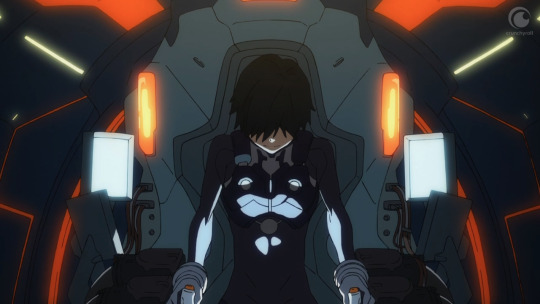
Mitchiri Neko
Hard pass. If you’re gonna watch a banal, cutesy, 3-minute runtime cat show - like, if you really need that - watch Bananya.
#anime review#anime#sanrio danshi#ramen daisuki koizumi-san#yuru camp#sora yori mo tooi basho#cardcaptor sakura#violet evergarden#pop team epic#darling in the franxx#mitchiri neko
3 notes
·
View notes
Text
The earth has circled the sun 365 days and it is once again Darren Criss’ birthday. As has become tradition here at 4YE, we cannot pass February 5 without honouring one of our favourite humans. We’ve had our favourite original songs, the best things about entering your 30s, our hopes and dreams for his coming year, and songs we’d like to see him cover, just to name a few.
As well as being up there at the top of his singing, acting and songwriting game, Darren is also known for his iconic looks. Be it on screen or off, Darren has gifted us with his numerous looks that show off his own sense of style and confidence that fans cannot help but think of Darren when seeing. For his 32nd birthday, 4YE wants to take you on a journey of just a few of these looks.
His You-Tube Days
Before you could tune in each week to hear him cover songs on Glee, Darren was taking full advantage of a new video-sharing platform and uploading songs he had recorded in his bedroom. This is raw, bushy haired Darren and so much fun to look back on. Check out his Glee audition below.
youtube
I’m Harry-freaking-Potter
Darren’s work in Starkid’s A Very Potter Musical and its two subsequent sequels is where Darren got his first break and was introduced to an international audience after the videos were uploaded to YouTube and went viral among millions of Harry Potter fans. The songs, the humour, the camaraderie between the cast and the catchy, pop songs made these musicals fan favourites. It’s no wonder that the first part of the first musical having currently amassed more than 15 million views. It also didn’t hurt that Darren looked an awfully like Harry Potter himself and so provided us really with the first iconic Darren look.
Credit: Team Starkid
Our Teenage Dream – Blaine “Warbler” Anderson
It’s hard to believe that it was only just over eight years ago that Blaine Anderson burst onto our screens and into both Kurt Hummel and our hearts. With his preppy Dalton Academy uniform, his oh-so-smooth and flirty vocals on his hit cover of Katy Perry’s “Teenage Dream” and his wise and put-together bravado, it’s no surprise that his small guest spot turned into a series regular position and a coveted spot as one half of the iconic Klaine. You can’t think of early Blaine Anderson without the Dalton uniform, though there was some momentous occasions when we did see him out of the suit and tie.
1950s Dreamboat Blaine Anderson
We are not exactly sure what started it as it certainly wasn’t that evident in season 2, but from Blaine’s transfer to McKinley High, we were presented with 1950s Dreamboat, Dapper Darren. The ever-present bowtie, the polo shirts, a cardigan or sweater vest depending on the season, these aren’t exactly elements that would bring guys and girls to their knees. Yet somehow Darren rocked it and we were ever so grateful.
This slideshow requires JavaScript.
Taking The Dapper Look To Broadway In How To Succeed In Business Without Really Trying
Channeling Blaine Anderson’s dapperness, Darren lit up Broadway’s stage in his debut playing the ambitious J. Pierrepont Finch in a three week run of How to Succeed in Business Without Really Trying.
Credit: Bruce Glikas/Broadway.com
Putting On Some Make-Up And Pulling The Wig Down From The Shelf For Hedwig
Over the years a number of people have put on Hedwig’s wig taking to the stage as the eponymous character in the musical Hedwig and the Angry Inch. Over its 18 month Broadway run in 2014-15, Darren was just one of the draw-crowd stars to bring her to life. And he was the youngest actor to tackle the part. A hit with fans and dream-come-true character to play for Darren, he reprised the role for the San Francisco and LA legs of the tour production in 2016.
Credit: Joan Marcus
Killing Versace In American Crime Story
While there were definitely some notable looks from his award-winning turn as Andrew Cunanan in the latest season of American Crime Story – The Assassination of Gianni Versace, there were two in particular that have had a lasting impression on viewers and regularly pop up on the socials. That is of course THAT speedo and the red pantsuit. Both of these images will no doubt be doing the rounds for many years to come.
Darren Criss Dancing GIF from Darrencriss GIFs
Darren Criss Andrew Cunanan GIF from Darrencriss GIFs
The Photo Shoot That Broke The Internet
For those in the fandom for a while, you know exactly what photo shoot I’m referring to here. It started out like any other weekend and then suddenly manna from Heaven was dropped to us all with the release of approximately 100 photos from People magazine recent beach photo shoot with Darren to celebrate his Sexiest Man award. Did anyone get anything done at all for the next few days?
This slideshow requires JavaScript.
The Pink Sunnies
A staple since his early days, Darren is known for his love of bright, bold colours and incorporating this into his look. This is none-so-evident as in his choice of sunglasses. While he has been known to rock shades with yellow, blue, white and the traditional black elements, it’s his signature pink sunnies that have left a lasting impression. Not to mention their way into many a fan’s collection.
Painted Nails
While Darren has been called upon to paint his nails for roles from time to time (such as Hedwig), Darren has been known to add more colour to his life by painting his nails. Be it all one colour to perfectly accessorise an outfit/award ceremony, or a mixture of colours because… well why not, Darren always looks good with a touch of colour.
Credit: Darren Criss/Twitter
Credit: aol
Credit: Bruce Glikas/FilmMagic
Socks
Darren loves his accessories as we’ve seen and the quirkier/more fun the better. Life is never boring for Darren so why should his clothes be any different. Over the years we’ve seen glimpses of his fun style with socks… and who doesn’t love interesting socks?
Credit: Cinderella Broadway/Twitter
Credit: Fashion of Glee
Credit: Fashion of Glee
Credit: Fashion of Glee
Credit: Fashion of Glee
Or you know… go without
Another common footwear choice by both Darren and Blaine is to go sockless. Those Victorians were right about the appeal in showing a little ankle.
This slideshow requires JavaScript.
University of Michigan Pride
It’s pretty hard to miss that Darren is an alum from UMich. If his tweets and pics don’t give it away, his shout out to his alma mater at the end of his Emmy’s acceptance speech last year kinda sealed the deal. But it’s not only the “Go Blue” shoutouts and hashtags, Darren can regularly be seen sporting UMich apparel.
Credit: Darren Criss/Twitter
Sweaty Darren Performance Mode
Anyone that has ever seen Darren perform live knows that the man gives it his all for every show. That means he rarely leave the stage not dripping… a look that becomes him well.
This slideshow requires JavaScript.
Wear A Suit And Tie And Make It Your Own
Over the past decade, Darren has graced a number of red carpets. From premieres to award shows, to galas and special events, Darren knows how to work a red carpet. He’s also never afraid to play around with what he wears… and hardly ever makes a wrong step. He takes the traditional tux/suit and tie and makes it his own.
This slideshow requires JavaScript.
Darren Criss Award Winner
This is the most recent look he has been rocking, and this is certainly one of our favourites. He has swept the field for his portrayal of Andrew Cunanan, taking home the Emmy, the Golden Globe, the Critics’ Choice and the Screen Actors Guild awards. While hardly an overnight success (we’ve been following him for almost a decade now), this role and the recognition it has garnered him has elevated him in the public’s notice and no doubt many in Hollywood and beyond are taking notice. We can’t wait for what’s next and many more examples of this look.
Credit: Ruben V. Nepales
Credit: Jordan Strauss / Invision / AP
Credit: Kevin Winter/Getty Images North America
Credit: Getty
Happy 32nd birthday Darren. We hope you have a totally awesome day!
4YE Celebrates Darren Criss’ 32nd Birthday With A Look At Some Of His Iconic looks On And Off Screen The earth has circled the sun 365 days and it is once again Darren Criss' birthday. As has become tradition here at…
#darren criss#Darren Criss birthday#glee#StarKid#The Assassination of Gianni Versace: American Crime Story
1 note
·
View note